敏斯特雕塑十年展
第4届敏斯特雕塑十年展 / 德国敏斯特
开幕时间:2007年6月16日
展览时间:2007年6月17日- 2007年9月30日
联系:
Westphalian State Museum of Art and Cultural History
Domplatz 10, D-48143 Muenster, Germany 德国
电子邮件:[email]mail@skulptur-projekte.de
网站:
[url]http://www.skulptur-projekte.de
2007年夏天第4届敏斯特雕塑10年展开幕。
自从1977年,这个展览是每十年办的; 1977、1987、1997这个展览每次邀请国际艺术家来敏斯特制作新作品。目前过去展览的33个雕塑已经被展出。Claes Oldenburg 的1977年雕塑 “Giant Pool Balls” 变成这个城市的一个象征。
[attachment=44153]
Giant Pool Balls
第4个敏斯特10年展将在2007年夏天开幕。自从1977年这个展览邀请国家各个地方的艺术家制作新作品。
这次展览是2007年6月17日开幕,由Kasper Konig教授 (科隆的Ludwig美术馆),Brigitte Franzen 教授 (敏斯特的Westphalian State 美术馆)和 Carina PLath 教授(敏斯特的Westphalian State 美术馆)策划的。他们邀请了37个艺术家来参加这次展览。
这个展览的题目 “雕塑方案”描述艺术家对当代雕塑的分析而雕塑对公共空间的影响。
这些“雕塑方案”将分析艺术、城市和观众的关系。作品将在敏斯特制作而在城市的不同地方展出,影响城市的外表。
这个展览由Landschaftsverband Westfalen-Lippe (LWL)协会,敏斯特城市和Westphalia赞助。
展览由Westphalian美术馆及艺术和文化历史美术馆主办。
Exhibition
The fourth international sculpture projects muenster opens in the summer of 2007. Since 1977 this large exhibition invites artists from all over the world to create new work in the city of Muenster. The events have put Muenster on the map of world renowned addresses for contemporary art.
sculpture projects muenster 07 opens on June 16, 2007 and runs parallel with the documenta in Kassel, from June 17 to September 30, 2007. For one hundred days, the exhibition will put its stamp on the city and the region. In 1997 more than 500.000 visitors came to Muenster to see the work of artists from 25 countries. This large attendance certainly raises similar expectations for 2007.
The curators Prof. Kasper König (Museum Ludwig, Cologne) and Dr. Brigitte Franzen (Westphalian State Museum, Muenster), and Associate Curator Dr. Carina Plath (Westphalian Art Association, Muenster) have invited 37 artists to participate in the exhibition.
The title of the exhibition, sculpture projects, is more than just a name: as in previous years, the artists participating in the 2007 exhibition will again examine the character of contemporary sculpture, its self-positioning in as well as its capacity to change the appearance of public space. As in 1977, 1987, and 1997, sculpture projects will examine the interdependence between the arts, the city, and the public. The sculptures will be created mostly in Muenster and installed throughout the city. By incorporating the works of art, the city gradually changes its face – a dynamic process is set in motion.
The exhibition sculpture projects is primarily funded by the Landschaftsverband Westfalen-Lippe (LWL), an association of regional communities, the city of Muenster, and the federal state of North-Rhine Westphalia.
sculpture projects muenster 07 is organized by the Westphalian State Museum of Art and Cultural History.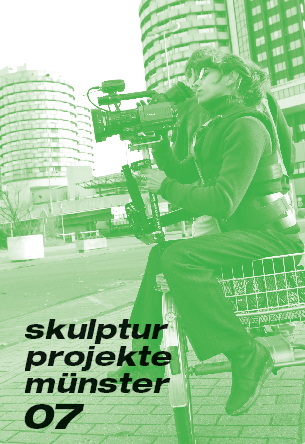
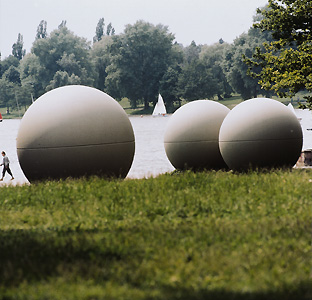
第4届敏斯特雕塑十年展 / 德国敏斯特
开幕时间:2007年6月16日
展览时间:2007年6月17日- 2007年9月30日
联系:
Westphalian State Museum of Art and Cultural History
Domplatz 10, D-48143 Muenster, Germany 德国
电子邮件:[email]mail@skulptur-projekte.de
网站:
[url]http://www.skulptur-projekte.de
2007年夏天第4届敏斯特雕塑10年展开幕。
自从1977年,这个展览是每十年办的; 1977、1987、1997这个展览每次邀请国际艺术家来敏斯特制作新作品。目前过去展览的33个雕塑已经被展出。Claes Oldenburg 的1977年雕塑 “Giant Pool Balls” 变成这个城市的一个象征。
[attachment=44153]
Giant Pool Balls
第4个敏斯特10年展将在2007年夏天开幕。自从1977年这个展览邀请国家各个地方的艺术家制作新作品。
这次展览是2007年6月17日开幕,由Kasper Konig教授 (科隆的Ludwig美术馆),Brigitte Franzen 教授 (敏斯特的Westphalian State 美术馆)和 Carina PLath 教授(敏斯特的Westphalian State 美术馆)策划的。他们邀请了37个艺术家来参加这次展览。
这个展览的题目 “雕塑方案”描述艺术家对当代雕塑的分析而雕塑对公共空间的影响。
这些“雕塑方案”将分析艺术、城市和观众的关系。作品将在敏斯特制作而在城市的不同地方展出,影响城市的外表。
这个展览由Landschaftsverband Westfalen-Lippe (LWL)协会,敏斯特城市和Westphalia赞助。
展览由Westphalian美术馆及艺术和文化历史美术馆主办。
Exhibition
The fourth international sculpture projects muenster opens in the summer of 2007. Since 1977 this large exhibition invites artists from all over the world to create new work in the city of Muenster. The events have put Muenster on the map of world renowned addresses for contemporary art.
sculpture projects muenster 07 opens on June 16, 2007 and runs parallel with the documenta in Kassel, from June 17 to September 30, 2007. For one hundred days, the exhibition will put its stamp on the city and the region. In 1997 more than 500.000 visitors came to Muenster to see the work of artists from 25 countries. This large attendance certainly raises similar expectations for 2007.
The curators Prof. Kasper König (Museum Ludwig, Cologne) and Dr. Brigitte Franzen (Westphalian State Museum, Muenster), and Associate Curator Dr. Carina Plath (Westphalian Art Association, Muenster) have invited 37 artists to participate in the exhibition.
The title of the exhibition, sculpture projects, is more than just a name: as in previous years, the artists participating in the 2007 exhibition will again examine the character of contemporary sculpture, its self-positioning in as well as its capacity to change the appearance of public space. As in 1977, 1987, and 1997, sculpture projects will examine the interdependence between the arts, the city, and the public. The sculptures will be created mostly in Muenster and installed throughout the city. By incorporating the works of art, the city gradually changes its face – a dynamic process is set in motion.
The exhibition sculpture projects is primarily funded by the Landschaftsverband Westfalen-Lippe (LWL), an association of regional communities, the city of Muenster, and the federal state of North-Rhine Westphalia.
sculpture projects muenster 07 is organized by the Westphalian State Museum of Art and Cultural History.


About the curators 关于策划人
[attachment=44237]
Professor Kasper König
Professor Kasper König (*1943) was only twenty-three years old when he curated the Claes Oldenburg exhibition in a museum in Stockholm. While still a student, he organized several exhibitions and published numerous books. In 1985, König became Professor of Art and the Public, a then newly created position at the Academy of Fine Arts in Düsseldorf. Three years later, he accepted a professorship at the Städelschule Frankfurt, where he has served as president of this fine arts college since 1989. During this same period he became founding director of the Portikus, an exhibition hall in Frankfurt/Main. König has organized several large exhibitions, including Westkunst (1981) in the Messehallen, Cologne; von hier aus (1984) in the Messe, Düsseldorf; and Der zerbrochene Spiegel (1993) in Vienna and Hamburg. In 2000 he was responsible for In-Between Architecture, the arts projects of the EXPO Hannover, and was also appointed director of the Museum Ludwig in Cologne. Together with Klaus Bußmann, he organized the first sculpture projects muenster in 1977.
Kasper Konig 教授(出生于1943)1966年时在瑞典的斯德哥尔摩美术馆策划了Claes Oldenburg的展览,他当时只23岁。
学生的时候也策划了几个展览而写了几本书。1985年,Konig在德国杜塞尔多夫美术学院当艺术教授了。三年以后,在弗兰克福特的美术学院当教授而自从1989年当这个学院的总监。
他策划的展览包含 Westkunst (1981); von hier aus (1984) 和 Der zerbrochene Spiegel (1993)。
2000年他负责建筑设计计划在汉诺威的展览,也当科隆的Ludwig美术馆的总监。跟Laus Bussmann 1977年时一起主办第一个敏斯雕塑10年展。
[attachment=44238]
Dr. Brigitte Franzen
An art historian and cultural studies scholar, Dr. Brigitte Franzen (*1966) became curator for contemporary art for the Westphalian State Museum for Art and Cultural History in 2005. She studied art history, European ethnology, German literature, and sociology at the universities of Karlsruhe, Vienna, and Marburg/Lahn. Between 1994 and 2005 she taught at the University of Wuppertal, the University of the Arts Berlin, the Technical University Graz, and the Academy of Fine Arts Munich. She has also worked at the Museum of Modern Art, Vienna (1990/91), the Albertina, Vienna (1990/91), the Museum of Modern Art, Frankfurt/Main (1991-1994), the Badisches Landesmuseum, Karlsruhe (1996/97), and the forum Stadtpark, Graz (2001-2003). Between 2003 and 2006 she codirected Microlandscapes, a research project financed by the Volkswagen Foundation. Franzen is the author of Die vierte Natur: Gärten in der zeitgenössischen Kunst (2000) and coeditor of Landschaftstheorie (2005).
Brigitte Franzen (出生于1966年)教授是艺术时和文化学家。2005年当Westphalian美术馆的当代艺术策划人。她学了艺术时,欧洲人类学,德国文学,社会科学。1994年至2005年她在Wuppertal大学、柏林美术学院,Graz 技术学院,慕尼黑美术学院当教授。
她在不同的美术馆工作过:1990年和1991年在维也纳的现代美术馆,1991年至1994年在弗兰克福的现代美术馆,1996-1997年在Karlsruhe和2001-2003年在Graz的Stadtpark.
2003年-2006年也合办Microlandscapes,也写了Die vierte Natur: Gärten in der zeitgenössischen Kunst。
[attachment=44239]
Dr. Carina Plath
Dr. Carina Plath (*1966) studied art history, classical archaeology, and Romance languages and literature at the universities of Muenster, Bologna, Munich, and Bochum. She received her PhD from the University of Bochum with a thesis on Maria Nordman’s work of the 1970s. From 1994 to 2001, Plath worked as an art critic for Das Kunst-Bulletin (Zurich) and neue bildene Kunst (Berlin). She has also written numerous essays on contemporary art for catalogues and reference book entries. From 1999 to 2001, she was enrolled in the curatorial studies program at Bard College, Annandale-on-Hudson, New York. In 2000, she curated image a new, an exhibition at the Center for Curatorial Studies, New York, as well as Platino, at the Goethe Institute, New York. Since 2001, she has been director of the Westfälischer Kunstverein, an art association for which she has realized the following exhibitions: formal social (2002); Prisoners - a project by Pawel Althamer (2002); Wilhelm Sasnal (2003); STREIK (2003); Valérie Favre (2004); Matthew Buckingham (2005); and T,O,U,C,H,I,N,G - Wahrnehmung und Film (2005).
Carina Plath 教授(出生于1966年)学了艺术时,考古学,文学。
1994年至2001年当Kunstbulleting 和 neue bildene Kunst 杂志的艺术评论家。从1999年到2001年,在纽约学了策划学习。
2000年在纽约策划Image a new和Platino. 自从2001年她当Westfalischer Kunstverein的总监,在那里策划了:formal social (2002), Prisoners (2002), Wilhelm Sasnal (2003), STREIK (2003), Valerie Favre (2004), Matthew Buckingham (2005). T,O,U,C,H,I,N,G, Wahrnehmung 和电影 (2005)

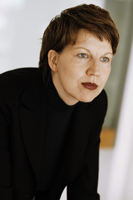
[attachment=44237]
Professor Kasper König
Professor Kasper König (*1943) was only twenty-three years old when he curated the Claes Oldenburg exhibition in a museum in Stockholm. While still a student, he organized several exhibitions and published numerous books. In 1985, König became Professor of Art and the Public, a then newly created position at the Academy of Fine Arts in Düsseldorf. Three years later, he accepted a professorship at the Städelschule Frankfurt, where he has served as president of this fine arts college since 1989. During this same period he became founding director of the Portikus, an exhibition hall in Frankfurt/Main. König has organized several large exhibitions, including Westkunst (1981) in the Messehallen, Cologne; von hier aus (1984) in the Messe, Düsseldorf; and Der zerbrochene Spiegel (1993) in Vienna and Hamburg. In 2000 he was responsible for In-Between Architecture, the arts projects of the EXPO Hannover, and was also appointed director of the Museum Ludwig in Cologne. Together with Klaus Bußmann, he organized the first sculpture projects muenster in 1977.
Kasper Konig 教授(出生于1943)1966年时在瑞典的斯德哥尔摩美术馆策划了Claes Oldenburg的展览,他当时只23岁。
学生的时候也策划了几个展览而写了几本书。1985年,Konig在德国杜塞尔多夫美术学院当艺术教授了。三年以后,在弗兰克福特的美术学院当教授而自从1989年当这个学院的总监。
他策划的展览包含 Westkunst (1981); von hier aus (1984) 和 Der zerbrochene Spiegel (1993)。
2000年他负责建筑设计计划在汉诺威的展览,也当科隆的Ludwig美术馆的总监。跟Laus Bussmann 1977年时一起主办第一个敏斯雕塑10年展。
[attachment=44238]
Dr. Brigitte Franzen
An art historian and cultural studies scholar, Dr. Brigitte Franzen (*1966) became curator for contemporary art for the Westphalian State Museum for Art and Cultural History in 2005. She studied art history, European ethnology, German literature, and sociology at the universities of Karlsruhe, Vienna, and Marburg/Lahn. Between 1994 and 2005 she taught at the University of Wuppertal, the University of the Arts Berlin, the Technical University Graz, and the Academy of Fine Arts Munich. She has also worked at the Museum of Modern Art, Vienna (1990/91), the Albertina, Vienna (1990/91), the Museum of Modern Art, Frankfurt/Main (1991-1994), the Badisches Landesmuseum, Karlsruhe (1996/97), and the forum Stadtpark, Graz (2001-2003). Between 2003 and 2006 she codirected Microlandscapes, a research project financed by the Volkswagen Foundation. Franzen is the author of Die vierte Natur: Gärten in der zeitgenössischen Kunst (2000) and coeditor of Landschaftstheorie (2005).
Brigitte Franzen (出生于1966年)教授是艺术时和文化学家。2005年当Westphalian美术馆的当代艺术策划人。她学了艺术时,欧洲人类学,德国文学,社会科学。1994年至2005年她在Wuppertal大学、柏林美术学院,Graz 技术学院,慕尼黑美术学院当教授。
她在不同的美术馆工作过:1990年和1991年在维也纳的现代美术馆,1991年至1994年在弗兰克福的现代美术馆,1996-1997年在Karlsruhe和2001-2003年在Graz的Stadtpark.
2003年-2006年也合办Microlandscapes,也写了Die vierte Natur: Gärten in der zeitgenössischen Kunst。
[attachment=44239]
Dr. Carina Plath
Dr. Carina Plath (*1966) studied art history, classical archaeology, and Romance languages and literature at the universities of Muenster, Bologna, Munich, and Bochum. She received her PhD from the University of Bochum with a thesis on Maria Nordman’s work of the 1970s. From 1994 to 2001, Plath worked as an art critic for Das Kunst-Bulletin (Zurich) and neue bildene Kunst (Berlin). She has also written numerous essays on contemporary art for catalogues and reference book entries. From 1999 to 2001, she was enrolled in the curatorial studies program at Bard College, Annandale-on-Hudson, New York. In 2000, she curated image a new, an exhibition at the Center for Curatorial Studies, New York, as well as Platino, at the Goethe Institute, New York. Since 2001, she has been director of the Westfälischer Kunstverein, an art association for which she has realized the following exhibitions: formal social (2002); Prisoners - a project by Pawel Althamer (2002); Wilhelm Sasnal (2003); STREIK (2003); Valérie Favre (2004); Matthew Buckingham (2005); and T,O,U,C,H,I,N,G - Wahrnehmung und Film (2005).
Carina Plath 教授(出生于1966年)学了艺术时,考古学,文学。
1994年至2001年当Kunstbulleting 和 neue bildene Kunst 杂志的艺术评论家。从1999年到2001年,在纽约学了策划学习。
2000年在纽约策划Image a new和Platino. 自从2001年她当Westfalischer Kunstverein的总监,在那里策划了:formal social (2002), Prisoners (2002), Wilhelm Sasnal (2003), STREIK (2003), Valerie Favre (2004), Matthew Buckingham (2005). T,O,U,C,H,I,N,G, Wahrnehmung 和电影 (2005)



About the artists 关于艺术家
Invited Artists (March 2007)
Pawel_Althamer | Michael_Asher | Nairy_Baghramian | Guy_Ben-Ner | Guillaume_Bijl | Martin_Boyce | Jeremy Deller | Michael_Elmgreen und Ingar_Dragset | Hans-Peter_Feldmann | Dora_Garcia | Isa_Genzken | Dominique_Gonzalez-Foerster | Tue_Greenfort | David_Hammons | Valérie_Jouve | Mike_Kelley | Suchan Kinoshita | Marko_Lehanka | Gustav_Metzger | Eva_Meyer und Eran_Schaerf | Deimantas_Narkevicius | Bruce_Nauman | Maria_Pask | Manfred_Pernice | Susan_Philipsz | Martha_Rosler | Thomas_Schütte | Andreas_Siekmann | Rosemarie_Trockel | Silke_Wagner | Mark_Wallinger | Clemens von Wedemeyer | Annette_Wehrmann | Pae_White
[attachment=44251]
Pawel Althamer
*1967 in Warsaw, lives and works in Warsaw
出生于1967年在波兰华沙。居住并工作与华沙
在他的作品里Pawel Althamer用古典雕塑的一些方面,装置的特点和一些社会元素。经常把一些日常生活的情况放在一个新的背景里,而改变阐明。1994年,他问了华沙的一个画廊的职员哪些物品会让他们的工作舒服一点,而提供给他们椅子,收音机,植物和饮料。
Althamer 作品里关注社会底阶层的人。在他的作品 "Dancers" (舞蹈家里),他请了一些无家可归的人互相拉手在一个光亮的空间里。他们不穿衣服,就不反映他们的社会阶层里。观众无法猜到他们的来历。他们的舞蹈表达人类的存在。
他参加了以下展览:
第四届柏林双年展,2006年,柏林
„Kontakt“, March-June 2006, MUMOK, Vienna 维也纳
„The Impossible Theatre“, February-April 2006, Barbican Centre, London 伦敦
„The New Reality of Europe“, January-March 2006, Museum of Contemporary Art, Tokyo 东京
„Positioning“, October 2005-January 2006, Hiroshima City Museum of Contemporary Art 日俄不能
作品计划
[attachment=46522]
Pawel Althamer: Pfad / Sciezka (Foto: Roman Ostojic/sp07)
Pawel Althamer 在这次敏斯特雕塑展会建造一个小路。这个小路从Lake Aa的一个自行车道开始一直到城市之外,通过田地……
小路长度为1000米,而会在一个麦田突然地结束。
出发点从Althamer在德国的经验来的。他发现路上的人认真地遵守规则:走路的人不会在自行车道走路,骑自行车的的人不会在人行道骑车。这个作品给另外一个选择,而让人离开这个逻辑的系统。
这条路,断断续续的,不象城市的其他路。它通过一个主干道一直到城市之外的田地。这个环境的变化影响人对这条路的视觉。
Pawel Althamer combines in his work aspects of classical sculpture, e.g. in his life-size figurative self-portrait made of hair and wax (1993), the characteristics of installations, and social elements. He frequently incorporates familiar everyday situations into new contexts, to cause shifts in interpretation. In 1994, he asked the museum attendants in an art gallery in Warsaw which objects would make their working day more pleasant, and then furnished seats, a radio, a potted plant and soft drinks.
People of the underprivileged classes play a major role in Althamer's works. He focuses on the artificiality of their involuntary difference. For "Dancers" (1997) he has a group of homeless people in a white, brightly lit room, to take each other's hands and dance in a circle. The dancers are naked, and without their clothes, they no longer reveal their social category. They could not be identified as homeless. Their dance became purely an expression of being human.
Althamer's creations can be seen as a new form of realism, that developed in Poland and other former East Block countries in the course of the political transformations of the early 1990s. Divested of their traditional patterns of orientation, artists, like Althamer, examine the world they live in and its values.
Althamer's works could/can be seen in the following exhibitions:
4th berlin biennale 2006, March-July 2006, Berlin
„Kontakt“, March-June 2006, MUMOK, Vienna
„The Impossible Theatre“, February-April 2006, Barbican Centre, London
„The New Reality of Europe“, January-March 2006, Museum of Contemporary Art, Tokyo
„Positioning“, October 2005-January 2006, Hiroshima City Museum of Contemporary Art
In Münster his art was last exhibited in 2002 in the individual show of "Prisoners" in the Westphalian Art Association.
Project description
For sculpture projects münster 07, Pawel Althamer will construct a path. Starting where a footpath and bicycle trail meet in a municipal recreation area near Lake Aa, Althamer’s path will lead, through meadows and fields, out of the city. Just short of one kilometre, however, it will abruptly end in the middle of a field of barley. Surprised that the trail has suddenly ended, visitors will have to decide how to react upon this open situation and how to return to the city.
Althamer's idea for this project stems from his observation of how pedestrians and bicyclists here strictly obey the signs designating their respective paths, conforming to regulations in a way that appears unusually stringent to the average Polish observer. Footpaths are not used by bicyclists, and bike trails are not used by pedestrians – and it seems that no one would even consider leaving the paths themselves and walking or riding straight through the fields. With his path, Althamer is looking for a way out of these orderly circumstances. At the same time, the artist questions the obviousness of the city's network of trails by offering an alternative that refuses to comply with the system's tacitly accepted logic.
The path, whose sporadic quality distinguishes it from the more permanent paths, passes by a main road leading out of Münster and enters an agricultural area on the outskirts of the city. Simultaneously, this change of environment alters the way that the path itself is perceived, as it is transformed from an intervention in the city's existing infrastructure into an adventurous way out of the routines of everyday urban living. Reminiscent of walks taken during childhood, the trail leads visitors into the countryside, past a small woodland area and across a stream –highlighting precisely the natural qualities that we often no longer perceive in our media-saturated world. At the place where it abruptly ends, the trail challenges visitors' ability to make a decision, to face the situation at hand, and to assume responsibility for themselves. The special appeal of this work lies in its capacity to change familiar patterns of action and create an open-ended situation in which visitors can – and, indeed, have to – renegotiate possibilities. It is work that, for the duration of the exhibition, will continually change and grow as each visitor takes his or her own individual decision.
Pawel Althamer 的过往作品
[attachment=44511]
[attachment=44512]
[attachment=44513]
[attachment=44520]
[attachment=44521]
[attachment=44522]
[attachment=44523]
The Dancers (1991) - Pawel Althamer
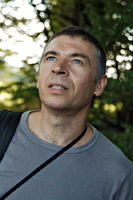
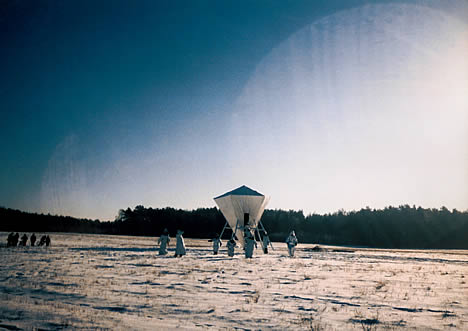


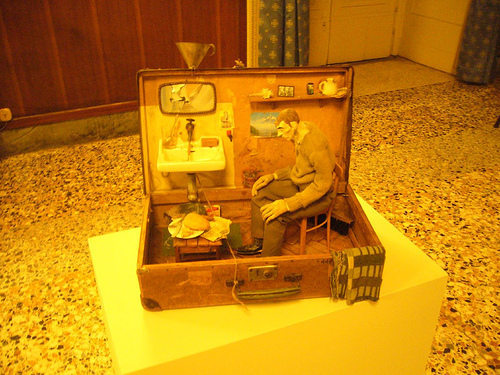
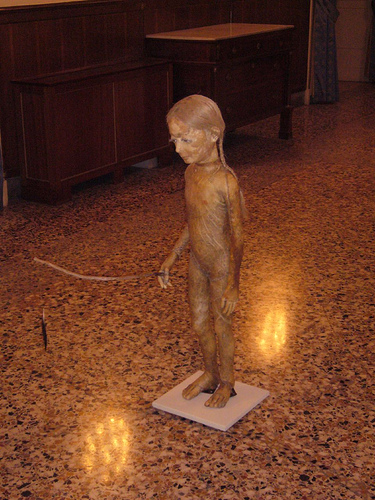


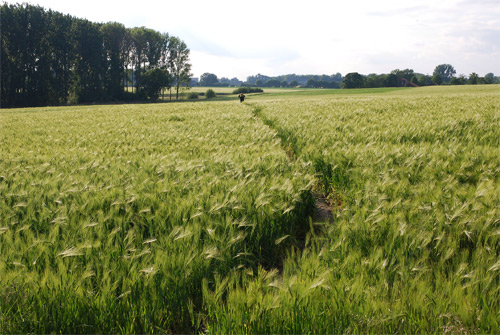
Invited Artists (March 2007)
Pawel_Althamer | Michael_Asher | Nairy_Baghramian | Guy_Ben-Ner | Guillaume_Bijl | Martin_Boyce | Jeremy Deller | Michael_Elmgreen und Ingar_Dragset | Hans-Peter_Feldmann | Dora_Garcia | Isa_Genzken | Dominique_Gonzalez-Foerster | Tue_Greenfort | David_Hammons | Valérie_Jouve | Mike_Kelley | Suchan Kinoshita | Marko_Lehanka | Gustav_Metzger | Eva_Meyer und Eran_Schaerf | Deimantas_Narkevicius | Bruce_Nauman | Maria_Pask | Manfred_Pernice | Susan_Philipsz | Martha_Rosler | Thomas_Schütte | Andreas_Siekmann | Rosemarie_Trockel | Silke_Wagner | Mark_Wallinger | Clemens von Wedemeyer | Annette_Wehrmann | Pae_White
[attachment=44251]
Pawel Althamer
*1967 in Warsaw, lives and works in Warsaw
出生于1967年在波兰华沙。居住并工作与华沙
在他的作品里Pawel Althamer用古典雕塑的一些方面,装置的特点和一些社会元素。经常把一些日常生活的情况放在一个新的背景里,而改变阐明。1994年,他问了华沙的一个画廊的职员哪些物品会让他们的工作舒服一点,而提供给他们椅子,收音机,植物和饮料。
Althamer 作品里关注社会底阶层的人。在他的作品 "Dancers" (舞蹈家里),他请了一些无家可归的人互相拉手在一个光亮的空间里。他们不穿衣服,就不反映他们的社会阶层里。观众无法猜到他们的来历。他们的舞蹈表达人类的存在。
他参加了以下展览:
第四届柏林双年展,2006年,柏林
„Kontakt“, March-June 2006, MUMOK, Vienna 维也纳
„The Impossible Theatre“, February-April 2006, Barbican Centre, London 伦敦
„The New Reality of Europe“, January-March 2006, Museum of Contemporary Art, Tokyo 东京
„Positioning“, October 2005-January 2006, Hiroshima City Museum of Contemporary Art 日俄不能
作品计划
[attachment=46522]
Pawel Althamer: Pfad / Sciezka (Foto: Roman Ostojic/sp07)
Pawel Althamer 在这次敏斯特雕塑展会建造一个小路。这个小路从Lake Aa的一个自行车道开始一直到城市之外,通过田地……
小路长度为1000米,而会在一个麦田突然地结束。
出发点从Althamer在德国的经验来的。他发现路上的人认真地遵守规则:走路的人不会在自行车道走路,骑自行车的的人不会在人行道骑车。这个作品给另外一个选择,而让人离开这个逻辑的系统。
这条路,断断续续的,不象城市的其他路。它通过一个主干道一直到城市之外的田地。这个环境的变化影响人对这条路的视觉。
Pawel Althamer combines in his work aspects of classical sculpture, e.g. in his life-size figurative self-portrait made of hair and wax (1993), the characteristics of installations, and social elements. He frequently incorporates familiar everyday situations into new contexts, to cause shifts in interpretation. In 1994, he asked the museum attendants in an art gallery in Warsaw which objects would make their working day more pleasant, and then furnished seats, a radio, a potted plant and soft drinks.
People of the underprivileged classes play a major role in Althamer's works. He focuses on the artificiality of their involuntary difference. For "Dancers" (1997) he has a group of homeless people in a white, brightly lit room, to take each other's hands and dance in a circle. The dancers are naked, and without their clothes, they no longer reveal their social category. They could not be identified as homeless. Their dance became purely an expression of being human.
Althamer's creations can be seen as a new form of realism, that developed in Poland and other former East Block countries in the course of the political transformations of the early 1990s. Divested of their traditional patterns of orientation, artists, like Althamer, examine the world they live in and its values.
Althamer's works could/can be seen in the following exhibitions:
4th berlin biennale 2006, March-July 2006, Berlin
„Kontakt“, March-June 2006, MUMOK, Vienna
„The Impossible Theatre“, February-April 2006, Barbican Centre, London
„The New Reality of Europe“, January-March 2006, Museum of Contemporary Art, Tokyo
„Positioning“, October 2005-January 2006, Hiroshima City Museum of Contemporary Art
In Münster his art was last exhibited in 2002 in the individual show of "Prisoners" in the Westphalian Art Association.
Project description
For sculpture projects münster 07, Pawel Althamer will construct a path. Starting where a footpath and bicycle trail meet in a municipal recreation area near Lake Aa, Althamer’s path will lead, through meadows and fields, out of the city. Just short of one kilometre, however, it will abruptly end in the middle of a field of barley. Surprised that the trail has suddenly ended, visitors will have to decide how to react upon this open situation and how to return to the city.
Althamer's idea for this project stems from his observation of how pedestrians and bicyclists here strictly obey the signs designating their respective paths, conforming to regulations in a way that appears unusually stringent to the average Polish observer. Footpaths are not used by bicyclists, and bike trails are not used by pedestrians – and it seems that no one would even consider leaving the paths themselves and walking or riding straight through the fields. With his path, Althamer is looking for a way out of these orderly circumstances. At the same time, the artist questions the obviousness of the city's network of trails by offering an alternative that refuses to comply with the system's tacitly accepted logic.
The path, whose sporadic quality distinguishes it from the more permanent paths, passes by a main road leading out of Münster and enters an agricultural area on the outskirts of the city. Simultaneously, this change of environment alters the way that the path itself is perceived, as it is transformed from an intervention in the city's existing infrastructure into an adventurous way out of the routines of everyday urban living. Reminiscent of walks taken during childhood, the trail leads visitors into the countryside, past a small woodland area and across a stream –highlighting precisely the natural qualities that we often no longer perceive in our media-saturated world. At the place where it abruptly ends, the trail challenges visitors' ability to make a decision, to face the situation at hand, and to assume responsibility for themselves. The special appeal of this work lies in its capacity to change familiar patterns of action and create an open-ended situation in which visitors can – and, indeed, have to – renegotiate possibilities. It is work that, for the duration of the exhibition, will continually change and grow as each visitor takes his or her own individual decision.
Pawel Althamer 的过往作品
[attachment=44511]
[attachment=44512]
[attachment=44513]
[attachment=44520]
[attachment=44521]
[attachment=44522]
[attachment=44523]
The Dancers (1991) - Pawel Althamer









Michael Asher
*1943 Los Angeles/USA, lives and works in Los Angeles
出生于1943在美国洛杉矶,居住并工作于洛杉矶
Michael Asher 参加了所有的敏斯特雕塑展。他在1977、1987、1997年的展览都用同样一个做法:把一个房车放在城市里的不同位置,修改城市的透视。每次记录摄影反映城市30年的发展。Asher 关注移动/运动以及场地的改变。在这30年里同样一个房车路了城市的不同地方。艺术家想通过空间的改变让观众意识到整理和安排的一些自动思路和系统。
Asher 参加了以下展览:
洛杉矶 1955-1985, 2006年3月-7月,蓬皮杜中心,法国巴黎
隐性艺术的历史,2005年11月-2006年2月,CCA Wattis, 美国三藩市
对焦:Michael Asher, 2005年9月-2006nia 1月,芝加哥艺术学院
作品方案
[attachment=46524]
Michael Asher: Caravan (1977) (Foto: Roman Mensing/sp07)
[attachment=46525]
Michael Asher: Caravan (1987) (Foto: Roman Mensing/sp07
[attachment=46526]
Michael Asher: Caravan (1997) (Foto: Roman Mensing/sp07)
Michael Asher将第四次展出房车作品。他在展览的这段时间里会把房车放在城市里的12个不同位置(每个星期移动房车)。他关注城市的固定与移动空间的冲突。经常把房车停在一些发展的地区。自从30年以前房车一直没改变,但城市不停地在发展。
Michael Asher has participated in the first three runs of the sculpture projects. He used the same methodology in 1977, 1987 and 1997. By positioning a caravan on different locations in the city of Münster, he develops a consistent setting for varying perspectives on the city. The minimalist-conceptual and early contextual game that began in 1977 became a lens for a model of urban development in 1987 and 1997. The immediate juxtaposition of the photographs, taken at the respective locations, shows if and to what extent urban contexts have changed in the last 30 years. Asher is, furthermore, interested in the aspect of mobility, produced by the constellation of standardised, immutable forms and changing sites: In the course of 30 years, the same caravan passes through different sites of the urban environment, without sustaining any transformation. In reference to art museums, Asher calls his experimental design and his method of changing perspectives, "dislocations". The artist wants to enhance our awareness of the automatic production of ideas concerning order and layout through shifts in space and modifications.
Ashers Works could/can be seen in the following exhibitions:
„Los Angeles 1955-1985“, March-July 2006, Centre Pompidou, Paris
„A Brief History of Invisible Art“, November 2005-February 2006, CCA Wattis, San Francisco
„Focus: Michael Asher“, September 2005-January 2006, Art Institute Chicago
Project Description
Michael Asher's art has been the central thread throughout sculpture projects. This American artist will present his caravan project in 2007 for the fourth time. During the whole period of the exhibit, he will park the caravan, the same model that he used already in 1977, 1987 and 1997, at twelve different locations, changing the site weekly. Asher uses rather unpretentious sites in the Münster scenery, sites that he chose back in 1977. The artist is mostly interested in exploring the area of conflict between rigid form and mobile space: For the past 30 years, the caravan has arrived at evolving locations in the city. The vehicle, itself, has remained the same. Asher's project has been documented in photos since 1977. These excellently show the dramatic transformation of the urban environment over the past 40 years.
过往作品
[attachment=44625]
[attachment=44626]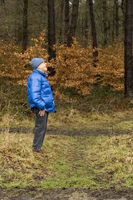
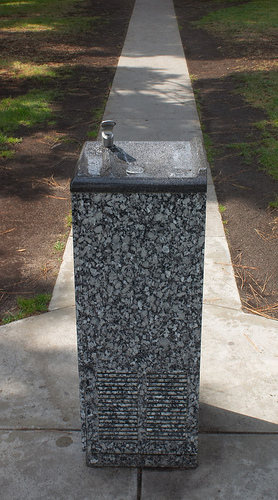
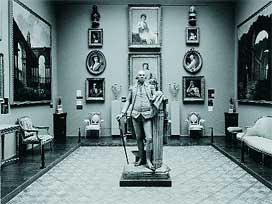

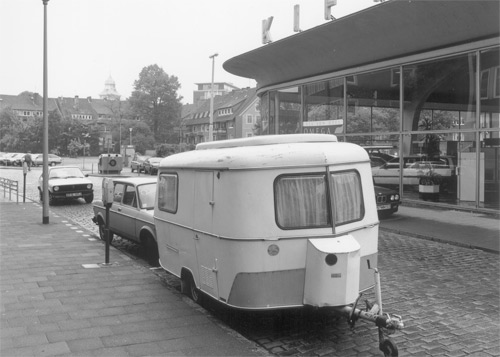
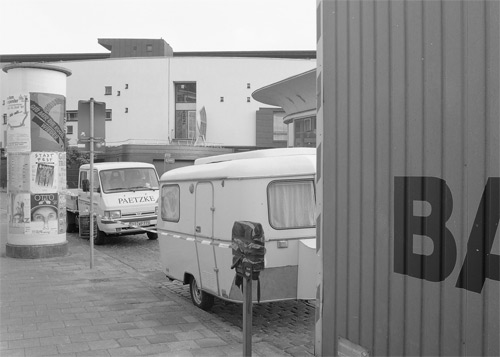
*1943 Los Angeles/USA, lives and works in Los Angeles
出生于1943在美国洛杉矶,居住并工作于洛杉矶
Michael Asher 参加了所有的敏斯特雕塑展。他在1977、1987、1997年的展览都用同样一个做法:把一个房车放在城市里的不同位置,修改城市的透视。每次记录摄影反映城市30年的发展。Asher 关注移动/运动以及场地的改变。在这30年里同样一个房车路了城市的不同地方。艺术家想通过空间的改变让观众意识到整理和安排的一些自动思路和系统。
Asher 参加了以下展览:
洛杉矶 1955-1985, 2006年3月-7月,蓬皮杜中心,法国巴黎
隐性艺术的历史,2005年11月-2006年2月,CCA Wattis, 美国三藩市
对焦:Michael Asher, 2005年9月-2006nia 1月,芝加哥艺术学院
作品方案
[attachment=46524]
Michael Asher: Caravan (1977) (Foto: Roman Mensing/sp07)
[attachment=46525]
Michael Asher: Caravan (1987) (Foto: Roman Mensing/sp07
[attachment=46526]
Michael Asher: Caravan (1997) (Foto: Roman Mensing/sp07)
Michael Asher将第四次展出房车作品。他在展览的这段时间里会把房车放在城市里的12个不同位置(每个星期移动房车)。他关注城市的固定与移动空间的冲突。经常把房车停在一些发展的地区。自从30年以前房车一直没改变,但城市不停地在发展。
Michael Asher has participated in the first three runs of the sculpture projects. He used the same methodology in 1977, 1987 and 1997. By positioning a caravan on different locations in the city of Münster, he develops a consistent setting for varying perspectives on the city. The minimalist-conceptual and early contextual game that began in 1977 became a lens for a model of urban development in 1987 and 1997. The immediate juxtaposition of the photographs, taken at the respective locations, shows if and to what extent urban contexts have changed in the last 30 years. Asher is, furthermore, interested in the aspect of mobility, produced by the constellation of standardised, immutable forms and changing sites: In the course of 30 years, the same caravan passes through different sites of the urban environment, without sustaining any transformation. In reference to art museums, Asher calls his experimental design and his method of changing perspectives, "dislocations". The artist wants to enhance our awareness of the automatic production of ideas concerning order and layout through shifts in space and modifications.
Ashers Works could/can be seen in the following exhibitions:
„Los Angeles 1955-1985“, March-July 2006, Centre Pompidou, Paris
„A Brief History of Invisible Art“, November 2005-February 2006, CCA Wattis, San Francisco
„Focus: Michael Asher“, September 2005-January 2006, Art Institute Chicago
Project Description
Michael Asher's art has been the central thread throughout sculpture projects. This American artist will present his caravan project in 2007 for the fourth time. During the whole period of the exhibit, he will park the caravan, the same model that he used already in 1977, 1987 and 1997, at twelve different locations, changing the site weekly. Asher uses rather unpretentious sites in the Münster scenery, sites that he chose back in 1977. The artist is mostly interested in exploring the area of conflict between rigid form and mobile space: For the past 30 years, the caravan has arrived at evolving locations in the city. The vehicle, itself, has remained the same. Asher's project has been documented in photos since 1977. These excellently show the dramatic transformation of the urban environment over the past 40 years.
过往作品
[attachment=44625]
[attachment=44626]






Nairy Baghramian
1971 in Isfahan, Iran, lives and works in Berlin
出生于1971在伊朗,居住并工作于德国柏林
她第一次个展为 "Es ist ausser Haus" (“在室外”)在巴塞尔的Kunsthalle。她用家居设计、时髦的元素来构成一个场景。
她作品里包含一些材料的历史,而带政治背景的叙述。欲望的典型现代物品,葡萄收成的机器,和摄影印刷品都拼在一起在一个框里。这些作品引证到权力的幻想游戏,以及与文学和话剧有关的对话局部。
展览作品
[attachment=46527]
Nairy Baghramian: Entr'acte (Foto: Roman Mensing/sp07)
[attachment=46528]
Nairy Baghramian: Entr'acte (Foto: Roman Mensing/sp07)
Nairy Baghramian was born in 1971 in Isfahan, Iran, and she lives and works in Berlin. Her exhibition "Es ist ausser Haus" (It is outside of the house) at the Kunsthalle Basel is the artist's first solo show in a public institution. The works of Nairy Baghramian are complex mise-en-scenes including elements of re-worked furniture design, set design and fashion. Her still lives in space involve references to material history, re-contextualized and turned into political statement. Classic modernist objects of desire, vintage apparel and photographic prints are fixed in the order imposed by hard-edged frames. These hybrid constructions can be read as stand-ins for imaginary games of power, but also as conversation pieces referring to literature and theatre. The sparse graphic form and the geometry of Baghramian's strangely corporeal sculptures generate captivating visual scenarios, a mechanical and optical ballet in which the gaze hits one scene after the other, directed by the prescribed movement of the viewer.
[attachment=44274]
VP, 2004 (过往作品)
Papier, Porzellan, Messing
210 x 195 x 50 cm
[attachment=44275]
"Es ist ausser Haus", 2006 (过往作品)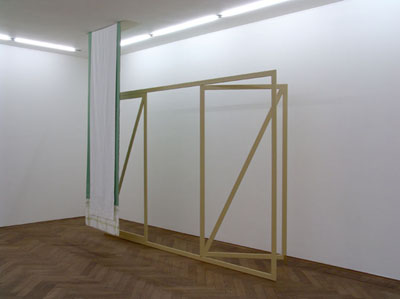
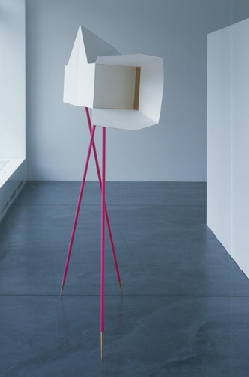
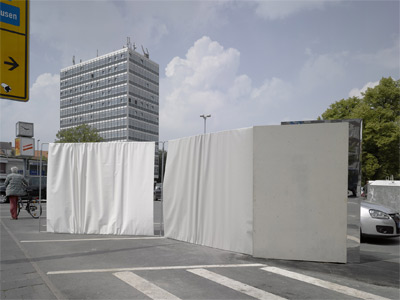
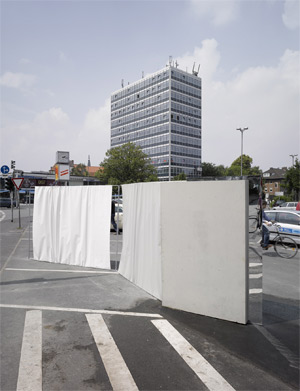
1971 in Isfahan, Iran, lives and works in Berlin
出生于1971在伊朗,居住并工作于德国柏林
她第一次个展为 "Es ist ausser Haus" (“在室外”)在巴塞尔的Kunsthalle。她用家居设计、时髦的元素来构成一个场景。
她作品里包含一些材料的历史,而带政治背景的叙述。欲望的典型现代物品,葡萄收成的机器,和摄影印刷品都拼在一起在一个框里。这些作品引证到权力的幻想游戏,以及与文学和话剧有关的对话局部。
展览作品
[attachment=46527]
Nairy Baghramian: Entr'acte (Foto: Roman Mensing/sp07)
[attachment=46528]
Nairy Baghramian: Entr'acte (Foto: Roman Mensing/sp07)
Nairy Baghramian was born in 1971 in Isfahan, Iran, and she lives and works in Berlin. Her exhibition "Es ist ausser Haus" (It is outside of the house) at the Kunsthalle Basel is the artist's first solo show in a public institution. The works of Nairy Baghramian are complex mise-en-scenes including elements of re-worked furniture design, set design and fashion. Her still lives in space involve references to material history, re-contextualized and turned into political statement. Classic modernist objects of desire, vintage apparel and photographic prints are fixed in the order imposed by hard-edged frames. These hybrid constructions can be read as stand-ins for imaginary games of power, but also as conversation pieces referring to literature and theatre. The sparse graphic form and the geometry of Baghramian's strangely corporeal sculptures generate captivating visual scenarios, a mechanical and optical ballet in which the gaze hits one scene after the other, directed by the prescribed movement of the viewer.
[attachment=44274]
VP, 2004 (过往作品)
Papier, Porzellan, Messing
210 x 195 x 50 cm
[attachment=44275]
"Es ist ausser Haus", 2006 (过往作品)




Guy Ben-Ner
*1969 Ramat Gan/Israel, lives and works in New York
出生于1969年在以色列,居住并工作于美国纽约
Guy Ben-Ner 参加了在2005年的威尼斯双年展就出名,当时展出的作品“Treehouse kit" (树房子套餐)是用家居的局部做的。这棵树变成一种生存的树。Ben-Ner 已经1999年在他作品 "Berkeley 岛" 提到了生存的问题:艺术家在他厨房里蹲坐在沙子上,在一棵树边上。Ben-Ner 反对家里人的角色。他做日常零星事务但讨论他的未完成的欲望,强调艺术家暴怒的偏见或野蛮人的偏见以及现代生活方式的荒唐方面。Ben-Ner 在他录像里用他自己的身体来代表有家庭的人。这些录像也描述艺术家回现实之后的态度。
Guy Ben-Ner 参加了以下展览:
第53个国际短片节,Oberhausen.
"Homesick Act I", May-June 2006 Akureyri Art Museum, Akureyri, Iceland, 冰岛
第52个国际短片节, Oberhausen, May 2006, Oberhausen
"Holy Land", April-December 2006, Heard Museum, Phoenix, Arizona, USA 美国
"Guy Ben-Ner: Honey, I shrunk the kids", September 2005-January 2006, Contemporary Arts Center, Cincinnati
作品方案
[attachment=46530]
Guy Ben-Ner: I'd give it to you if I could, but I borrowed it (Foto: Roman Mensing/sp07)
Guy Ben-Ner, 以色列艺术家,关注敏斯特的移动方面,也被叫成 “自行车的城市”。在他的作品“我原来如果能的话就把它送给你,但我自己是借过来的” Ben-Nur 会安装屏幕和录像设备在自行车上,而把这些自行车放在城市的不同位置。这些自行车,变成“幻想机器”。观众通过脚蹬子能够控制投影播放的速度,也可以把片子倒放。录像内容是艺术家在城市里奇自行车的记录。他的自行车是预先制成的物品。展览之前Guy Ben-Ner会把一些“现成”作品拆掉而用它们的一些局部来构成一个自行车。
这次计划是跟他的孩子一起合作的。他作品一直关注家庭、教育和家庭主人。
The video artist Guy Ben-Ner became internationally renowned when he represented Israel at the Venice Biennale in 2005. The work he presented there, ‚Treehouse Kit’, deals with a tree made of pieces of furniture, which the artist turns into a tree of survival. It might, thus, serve the modern version of a Robinson Crusoe. Ben-Ner, who completed his art studies in New York in 2003, was the lone survivor already when he showed ‚Berkeley’s Island’ (1999) – the artist squatting, stranded next to a palm tree on a sandy island, in the middle of his kitchen. The quasi domesticated artist is reluctant to accept the roles allocated today to family members. He does the chores, but discusses his unsatisfied desires, and stresses the incongruity between the cliché-like fury of the artist or the savagery of man, and modern lifestyles. Ben-Ner uses his body in the performance videos in order to paint the self-portrait of the family man (Edelsztein). It is also the family man who tries to transmit everyday culture to his son in ‚Wild boy’ (2004), or who, in ‚Moby Dick’ (2000), converts his kitchen into a whaler, which does not hunt legendary animals, as in Herman Melville's novel, but gets to the bottom of traditional myths. Ben-Ner's filmed self-portraits show the artist after he has arrived in reality.
Ben-Ner's works could/can be seen in the following exhibitions:
53rd International Short Film Festival Oberhausen, 3-8 May
2007, Oberhausen
„Homesick Act I“, May-June 2006 Akureyri Art Museum, Akureyri, Iceland
„52. Kurzfilmtage Oberhausen“, May 2006, Oberhausen
„Holy Land“, April-December 2006, Heard Museum, Phoenix, Arizona, USA
“Guy Ben-Ner: Honey, I shrunk the kids”, September 2005-January 2006, Contemporary Arts Center, Cincinnati
Project Description
Guy Ben-Ner, an Israeli artist, focuses on mobility in Münster, the "city of bikes". In his project "I`d give it to you if I could but I borrowed it" Ben-Ner will equip a number of bicycles with screens and video players, and place them around the city. These bikes, thus, become "image machines". The visitor controls the speed of projection by moving the pedals of the bikes, as well as make the film run forward or in reverse. The film shows the artist on a bicycle tour of the city. His bike is a ready-made object. Before the exhibit, Guy Ben-Ner will dismantle a number of well-known ready-mades, and reassemble them, to make a functioning bicycle. This project is being carried out by Guy Ben-Ner with his children. The family, education and the image of a man have always been themes of inspiration for Ben-Ner's art.
过往作品
[attachment=45087]
Berkeleys 岛,1999
[attachment=45088]
Berkeleys 岛,1999
[attachment=45089]
Elia, A story of an Ostric chicken, 2003
[attachment=45090]
Elia, A story of an Ostric chicken, 2003
[attachment=45091]
Elia, A story of an Ostric chicken, 2003
[attachment=45139]
Moby Dick, 2000
[attachment=45140]
Moby Dick, 2000
[attachment=45141]
Moby Dick, 2000
[attachment=45142]
Tree house kit
[attachment=45143]
Tree house kit
[attachment=45144]
Wild boy, 2004
[attachment=45145]
Wild boy, 2004
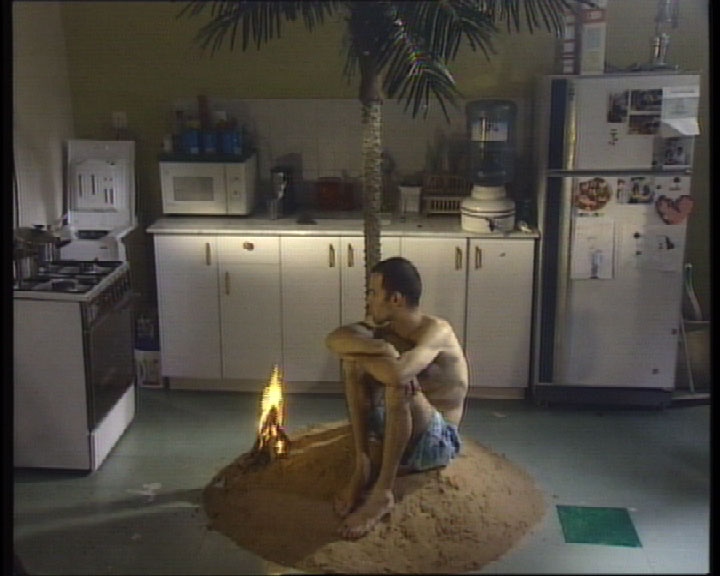
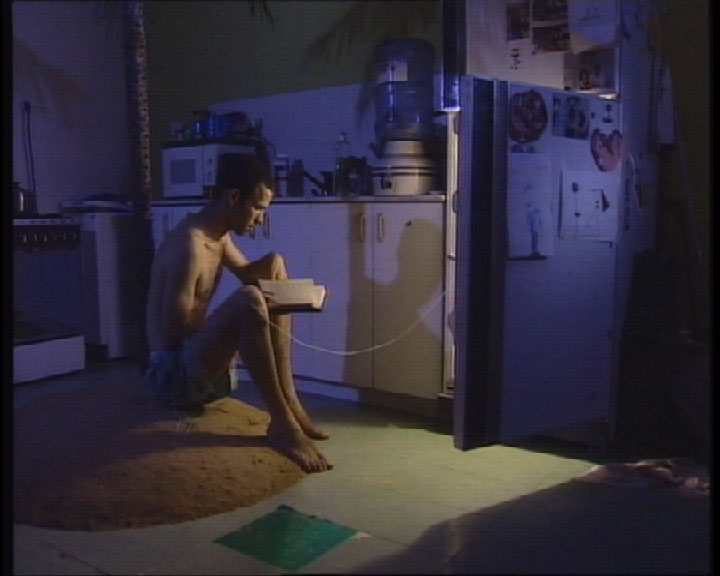


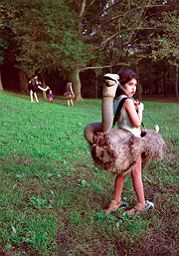
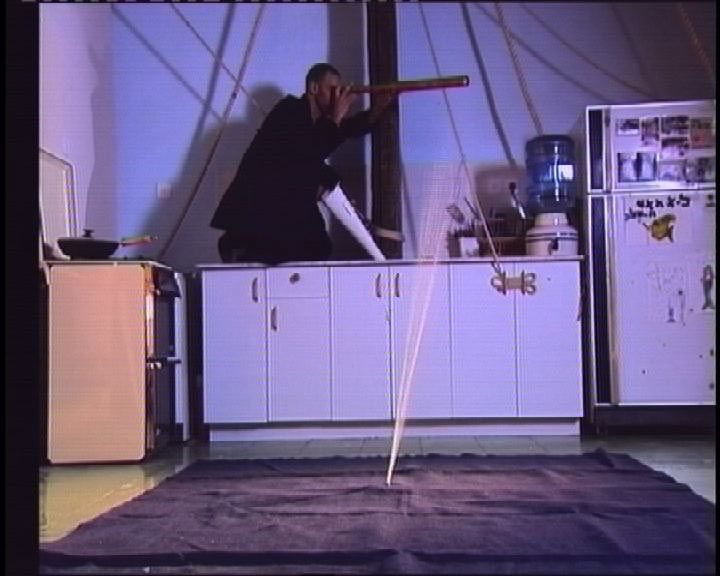
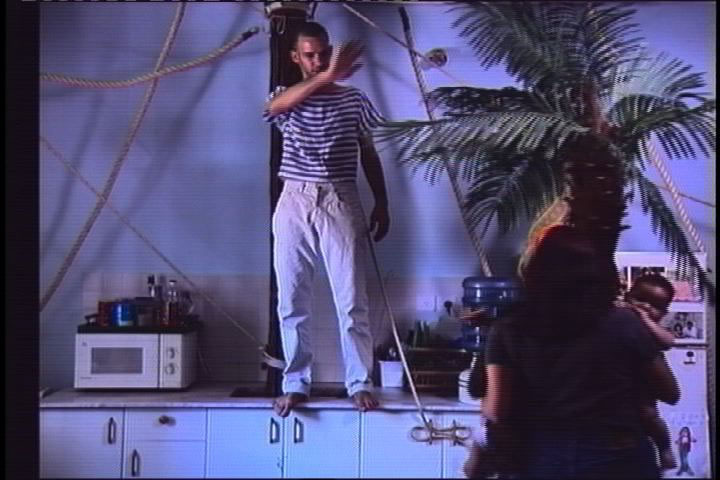
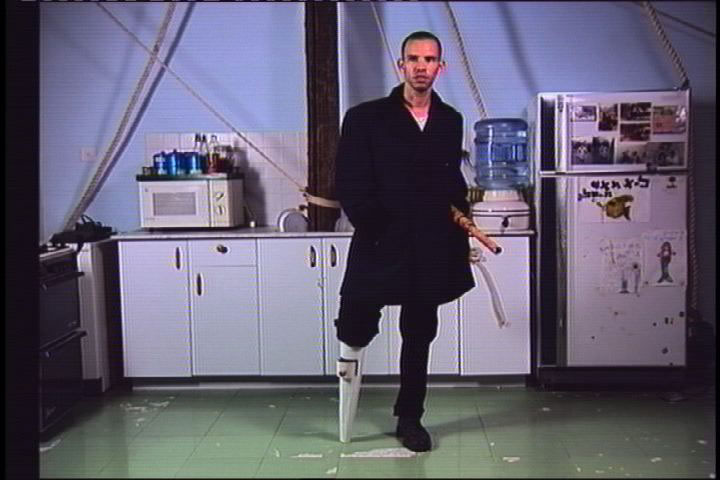
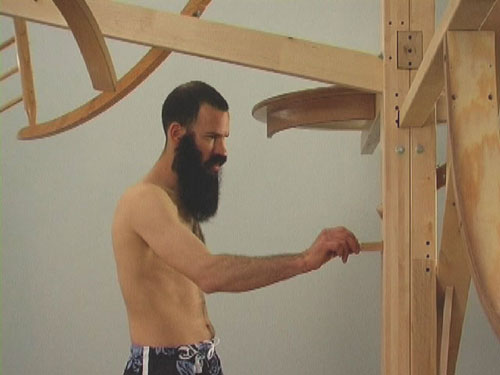
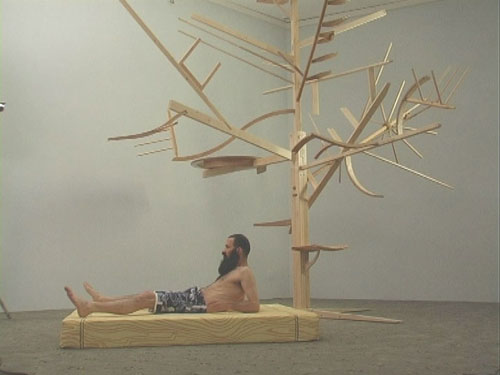
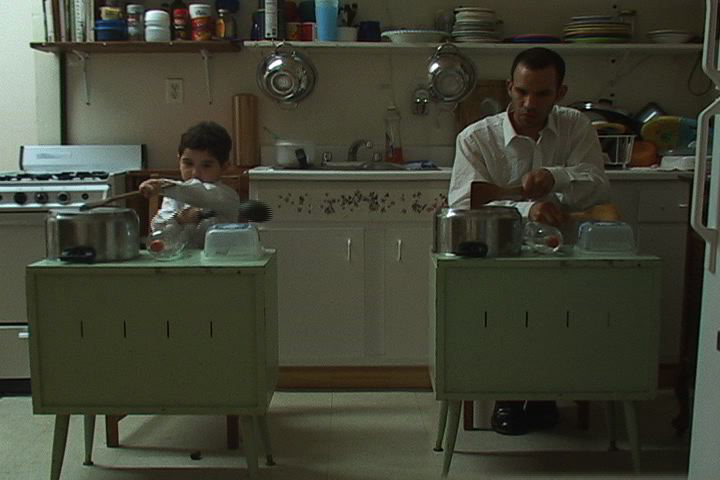
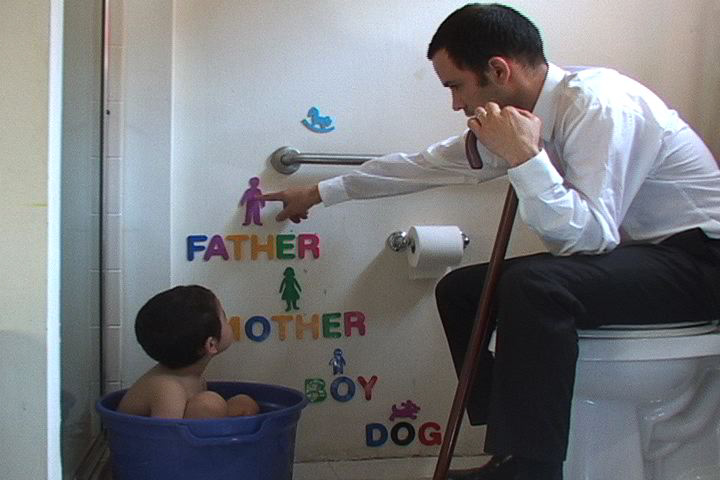
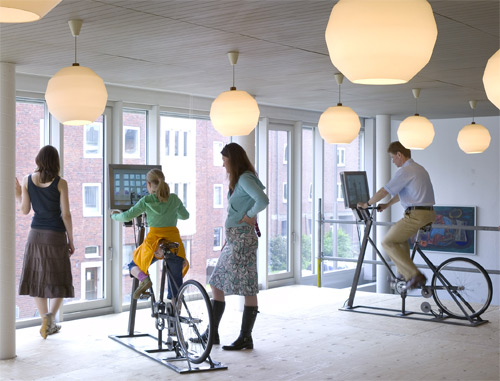
*1969 Ramat Gan/Israel, lives and works in New York
出生于1969年在以色列,居住并工作于美国纽约
Guy Ben-Ner 参加了在2005年的威尼斯双年展就出名,当时展出的作品“Treehouse kit" (树房子套餐)是用家居的局部做的。这棵树变成一种生存的树。Ben-Ner 已经1999年在他作品 "Berkeley 岛" 提到了生存的问题:艺术家在他厨房里蹲坐在沙子上,在一棵树边上。Ben-Ner 反对家里人的角色。他做日常零星事务但讨论他的未完成的欲望,强调艺术家暴怒的偏见或野蛮人的偏见以及现代生活方式的荒唐方面。Ben-Ner 在他录像里用他自己的身体来代表有家庭的人。这些录像也描述艺术家回现实之后的态度。
Guy Ben-Ner 参加了以下展览:
第53个国际短片节,Oberhausen.
"Homesick Act I", May-June 2006 Akureyri Art Museum, Akureyri, Iceland, 冰岛
第52个国际短片节, Oberhausen, May 2006, Oberhausen
"Holy Land", April-December 2006, Heard Museum, Phoenix, Arizona, USA 美国
"Guy Ben-Ner: Honey, I shrunk the kids", September 2005-January 2006, Contemporary Arts Center, Cincinnati
作品方案
[attachment=46530]
Guy Ben-Ner: I'd give it to you if I could, but I borrowed it (Foto: Roman Mensing/sp07)
Guy Ben-Ner, 以色列艺术家,关注敏斯特的移动方面,也被叫成 “自行车的城市”。在他的作品“我原来如果能的话就把它送给你,但我自己是借过来的” Ben-Nur 会安装屏幕和录像设备在自行车上,而把这些自行车放在城市的不同位置。这些自行车,变成“幻想机器”。观众通过脚蹬子能够控制投影播放的速度,也可以把片子倒放。录像内容是艺术家在城市里奇自行车的记录。他的自行车是预先制成的物品。展览之前Guy Ben-Ner会把一些“现成”作品拆掉而用它们的一些局部来构成一个自行车。
这次计划是跟他的孩子一起合作的。他作品一直关注家庭、教育和家庭主人。
The video artist Guy Ben-Ner became internationally renowned when he represented Israel at the Venice Biennale in 2005. The work he presented there, ‚Treehouse Kit’, deals with a tree made of pieces of furniture, which the artist turns into a tree of survival. It might, thus, serve the modern version of a Robinson Crusoe. Ben-Ner, who completed his art studies in New York in 2003, was the lone survivor already when he showed ‚Berkeley’s Island’ (1999) – the artist squatting, stranded next to a palm tree on a sandy island, in the middle of his kitchen. The quasi domesticated artist is reluctant to accept the roles allocated today to family members. He does the chores, but discusses his unsatisfied desires, and stresses the incongruity between the cliché-like fury of the artist or the savagery of man, and modern lifestyles. Ben-Ner uses his body in the performance videos in order to paint the self-portrait of the family man (Edelsztein). It is also the family man who tries to transmit everyday culture to his son in ‚Wild boy’ (2004), or who, in ‚Moby Dick’ (2000), converts his kitchen into a whaler, which does not hunt legendary animals, as in Herman Melville's novel, but gets to the bottom of traditional myths. Ben-Ner's filmed self-portraits show the artist after he has arrived in reality.
Ben-Ner's works could/can be seen in the following exhibitions:
53rd International Short Film Festival Oberhausen, 3-8 May
2007, Oberhausen
„Homesick Act I“, May-June 2006 Akureyri Art Museum, Akureyri, Iceland
„52. Kurzfilmtage Oberhausen“, May 2006, Oberhausen
„Holy Land“, April-December 2006, Heard Museum, Phoenix, Arizona, USA
“Guy Ben-Ner: Honey, I shrunk the kids”, September 2005-January 2006, Contemporary Arts Center, Cincinnati
Project Description
Guy Ben-Ner, an Israeli artist, focuses on mobility in Münster, the "city of bikes". In his project "I`d give it to you if I could but I borrowed it" Ben-Ner will equip a number of bicycles with screens and video players, and place them around the city. These bikes, thus, become "image machines". The visitor controls the speed of projection by moving the pedals of the bikes, as well as make the film run forward or in reverse. The film shows the artist on a bicycle tour of the city. His bike is a ready-made object. Before the exhibit, Guy Ben-Ner will dismantle a number of well-known ready-mades, and reassemble them, to make a functioning bicycle. This project is being carried out by Guy Ben-Ner with his children. The family, education and the image of a man have always been themes of inspiration for Ben-Ner's art.
过往作品
[attachment=45087]
Berkeleys 岛,1999
[attachment=45088]
Berkeleys 岛,1999
[attachment=45089]
Elia, A story of an Ostric chicken, 2003
[attachment=45090]
Elia, A story of an Ostric chicken, 2003
[attachment=45091]
Elia, A story of an Ostric chicken, 2003
[attachment=45139]
Moby Dick, 2000
[attachment=45140]
Moby Dick, 2000
[attachment=45141]
Moby Dick, 2000
[attachment=45142]
Tree house kit
[attachment=45143]
Tree house kit
[attachment=45144]
Wild boy, 2004
[attachment=45145]
Wild boy, 2004














Guillaume Bijl
*1946 in Antwerp/Belgium, lives and works in Antwerp and Münster
出生于1946年在比利时安特卫普,居住并工作于安特卫普和敏斯特。
Guillaume Bijl 的装置充满了反语和悟性,并建造一个设计和整理的幻想,使观众意识到公共制作品的无意的喜剧化。建造城市的整理感按照不同的要求对Bijl来说是一种幻想而变成他的作品的主题。Bijl 认为玩观众不是对他最好的试验。他的作品让人失望因为离现实很近的:比如,他的作品 "Roman Street" (罗马的路)1994年,在安特卫普像一个考古的场地。艺术家认为幻想是最好的办法来忍受内容的虚空。他关注文化旅游和娱乐生意。
他参加了以下展览:
50年 Documenta 1955-2005,卡塞尔
"(我的私人)英雄", 2005年, MARTa Herfort
"时间的影子", 2004年,法国巴黎
作品方案
[attachment=46541]
Guillaume Bijl: Archaeological Site (A Sorry-Installation)(Foto: Roman Mensing/sp07)
Guillaume Bijl 描述他的作品"Sorry's" (“道歉”)说是 "荒谬诗话": 当我1987年开始收藏一些物品的荒谬构成,就是说做抽象物品,我就对我现实的工作不“忠诚”,所以就叫成它们 “道歉”。Bijl 的计划叫 "考古场地 (一个对不起的装置)" 在敏斯特城市。在一个草地上他会建造一所6米高的山,中间挖一个8米深的洞。艺术家会把一个塔楼放在中间。敏斯特,这个城市的名字是从古代拉丁语来的:Monasterium (寺院), 所以艺术家不光下沉一个“被找到”的一个物品(塔楼)而也下沉在地下消失的城市和历史。
Guillaume Bijl's installations are full of irony and wit, and create an illusion of design and order, making us immediately aware of the ineptitude or the often involuntary comic of public productions. The attempts to establish order in the urban setting, and to shape it to correspond to various interests and requirements, is, according to Bijl, an illusion that becomes the motif of his art. His artistic program can neither be labelled „objet trouvé“ nor „context art“. Bijl has a priori doubts that you can experience the public by putting the public on stage, e.g. by furnishing the city. His installations deceive by presenting reality. Bijl's ‚Roman Street’ (1994) in the Middelheim Open Air Museum of Antwerp looks like an archaeological site. The artist believes that illusion is the only way to endure the lack of content and the void of things. His models are cultural tourism and the commercial recreational industry.
Bijl's works could/can be seen in the following exhibitions:
"50 Jahre/Years documenta 1955-2005", Sept.-Nov. 2005, Kunsthalle Fridericianum, Kassel
"(my private) heroes", May-Aug. 2005, MARTa Herford
"L’ombre du Temps", Sept. – Nov. 2004, Jeu de Paume, Paris
Project Description
It is "absurd poetry", says the Belgian artist, Guillaume Bijl, of his series of works entitled "Sorry's": *When, in 1987, I started compiling a number of absurd assemblages from existing objects, and thus made an abstraction, I was 'being unfaithful' to my own realistic form. I called those little works 'Sorries'." Bijl will enact a project entitled "Archeological Site (A Sorry Installation)" in the city of Münster. On a grassy area he will implant a hill, about six metres high, with a pit in its centre, about eight metres deep. A tower will be lowered into the central cavity. The name, Münster, is derived from the Latin term monasterium (monastery): The artist, therefore, sinks, not only an object that appears to be an objet trouvé, i.e. the tower, but also the city and its history disappear underground.
过往作品:
[attachment=45146]
inter-phone center, 2001
[attachment=45147]
新超市,2002
[attachment=45148]
新超市,2002
[attachment=45149]
道歉 Sorry ,2001
[attachment=45150]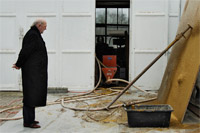
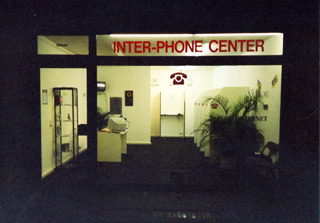
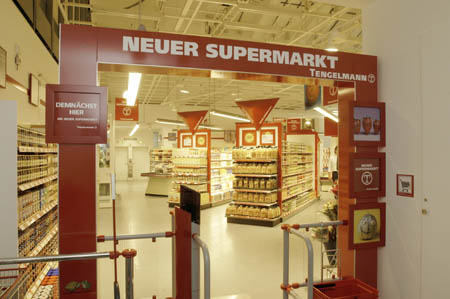
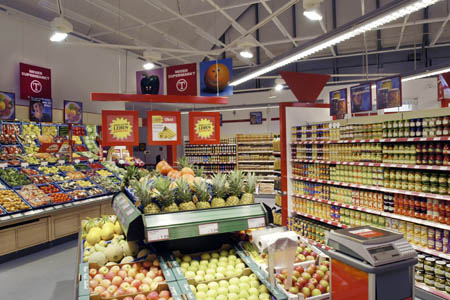
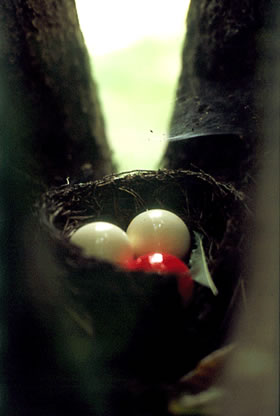
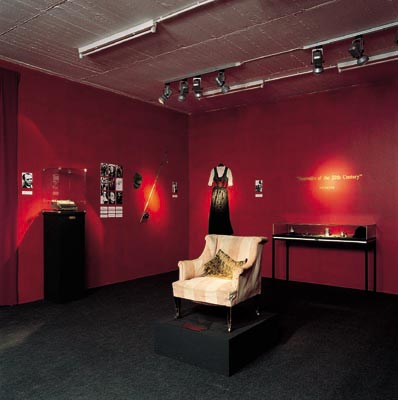
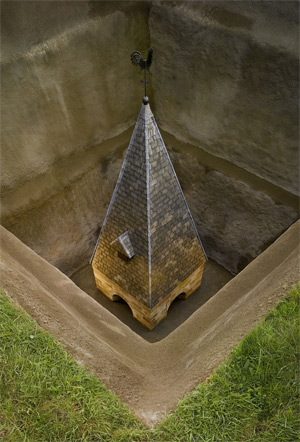
*1946 in Antwerp/Belgium, lives and works in Antwerp and Münster
出生于1946年在比利时安特卫普,居住并工作于安特卫普和敏斯特。
Guillaume Bijl 的装置充满了反语和悟性,并建造一个设计和整理的幻想,使观众意识到公共制作品的无意的喜剧化。建造城市的整理感按照不同的要求对Bijl来说是一种幻想而变成他的作品的主题。Bijl 认为玩观众不是对他最好的试验。他的作品让人失望因为离现实很近的:比如,他的作品 "Roman Street" (罗马的路)1994年,在安特卫普像一个考古的场地。艺术家认为幻想是最好的办法来忍受内容的虚空。他关注文化旅游和娱乐生意。
他参加了以下展览:
50年 Documenta 1955-2005,卡塞尔
"(我的私人)英雄", 2005年, MARTa Herfort
"时间的影子", 2004年,法国巴黎
作品方案
[attachment=46541]
Guillaume Bijl: Archaeological Site (A Sorry-Installation)(Foto: Roman Mensing/sp07)
Guillaume Bijl 描述他的作品"Sorry's" (“道歉”)说是 "荒谬诗话": 当我1987年开始收藏一些物品的荒谬构成,就是说做抽象物品,我就对我现实的工作不“忠诚”,所以就叫成它们 “道歉”。Bijl 的计划叫 "考古场地 (一个对不起的装置)" 在敏斯特城市。在一个草地上他会建造一所6米高的山,中间挖一个8米深的洞。艺术家会把一个塔楼放在中间。敏斯特,这个城市的名字是从古代拉丁语来的:Monasterium (寺院), 所以艺术家不光下沉一个“被找到”的一个物品(塔楼)而也下沉在地下消失的城市和历史。
Guillaume Bijl's installations are full of irony and wit, and create an illusion of design and order, making us immediately aware of the ineptitude or the often involuntary comic of public productions. The attempts to establish order in the urban setting, and to shape it to correspond to various interests and requirements, is, according to Bijl, an illusion that becomes the motif of his art. His artistic program can neither be labelled „objet trouvé“ nor „context art“. Bijl has a priori doubts that you can experience the public by putting the public on stage, e.g. by furnishing the city. His installations deceive by presenting reality. Bijl's ‚Roman Street’ (1994) in the Middelheim Open Air Museum of Antwerp looks like an archaeological site. The artist believes that illusion is the only way to endure the lack of content and the void of things. His models are cultural tourism and the commercial recreational industry.
Bijl's works could/can be seen in the following exhibitions:
"50 Jahre/Years documenta 1955-2005", Sept.-Nov. 2005, Kunsthalle Fridericianum, Kassel
"(my private) heroes", May-Aug. 2005, MARTa Herford
"L’ombre du Temps", Sept. – Nov. 2004, Jeu de Paume, Paris
Project Description
It is "absurd poetry", says the Belgian artist, Guillaume Bijl, of his series of works entitled "Sorry's": *When, in 1987, I started compiling a number of absurd assemblages from existing objects, and thus made an abstraction, I was 'being unfaithful' to my own realistic form. I called those little works 'Sorries'." Bijl will enact a project entitled "Archeological Site (A Sorry Installation)" in the city of Münster. On a grassy area he will implant a hill, about six metres high, with a pit in its centre, about eight metres deep. A tower will be lowered into the central cavity. The name, Münster, is derived from the Latin term monasterium (monastery): The artist, therefore, sinks, not only an object that appears to be an objet trouvé, i.e. the tower, but also the city and its history disappear underground.
过往作品:
[attachment=45146]
inter-phone center, 2001
[attachment=45147]
新超市,2002
[attachment=45148]
新超市,2002
[attachment=45149]
道歉 Sorry ,2001
[attachment=45150]







Martin Boyce
*1967 in Glasgow, lives and works in Glasgow and Berlin
出生于英国格拉斯哥,居住并工作于格拉斯哥和柏林
Martin Boyce 的作品内容在设计、建筑设计与日常生活的界面里。Boyce 关注物品的形式和作用而分析它们的概念。他参加了2003年里昂双年展,而获得Adolf Luther 基金会的艺术奖。他放弃了现代设计。在他作品里异常环境呈现。他作品"Fragile Landscapes" (脆弱风景)反应艺术家对设计的兴趣。他关注风景的概念,包括“断开或幻想的风景,普通的和原型的场景。他通过局部和细节描述这些风景。Boyce 说:“一个细节可以创建一个幻想适合居住的地方”。他作品内容也包含风景的建造和拆毁。
他参加了以下展览:
“如果不它不存在的话你就应该首创它”,2006年4月-5月,伦敦
Again for tomorrow, 2006年3月-4月,伦敦
Optik schroder, 2006年3月-4月,Kunstverein Brunswick
Punching through the clouds, 2006年1月-2月,纽约
Body, 2005年11月-2006年2月,美国
"Street: Behind the Cliché", Witte de With, Rotterdam 荷兰
"Electric Trees and Telephone Booth Conversations", FRAC des Pays de la Loire, Carquefou, 法国
"Dark Reflections", Adolf Luther Prize, Kaiser-Wilhelm-Museum, Krefeld,德国
"Our love is like the flowers, the rain, the sea and the hours" Tramway, Glasgow,英国
"For 1959 Capital Avenue", Museum für Moderne Kunst, Frankfurt,德国
展览作品
[attachment=46542]
Martin Boyce: We are still and reflective (Foto: Roman Mensing/sp07)
Martin Boyce works at the interface of design, architecture and daily life. Boyce addresses himself to the form and function of designed objects and analyses their concepts. He fundamentally disturbs the very substance of the works of Arne Jacobsen, Mies van der Rohe, and Charles and Ray Eames. He reinterprets and develops them further. Boyce, who participated in the Lyon Biennale of 2003 and received the Art Award of the Adolf Luther Foundation in Krefeld, abandons the modernist design. Disconcerting and strange environments come into being. Boyce's "fragile landscapes" underline the artist's interest in styling and design, which profoundly determine the human habitat and life. Boyce reflects the idea of landscape, including "fragmented or imaginary landscapes, generic and archetypical sites. These landscapes are often described through details and fragments." One detail, says Boyce, can "create an imaginary and habitable place". Even though the artist changes only a minor detail of the modernist classics of design, he is working on the construction and deconstruction of landscape.
Boyce's works could/can be seen in the following exhibitions:
„If it didn’t exist you’d have to invent it“, April/May 2006, The Showroom, London
„Again for tomorrow”, March/April 2006, Royal College of Art, London
„Optik Schröder“, March/April 2006, Kunstverein Brunswick
„Punching through the clouds“, January/February 2006, Tanya Bonakdar Gallery, New York
„Body“, November 2005-February 2006, Ottawa Art Gallery
"Street: Behind the Cliché", Witte de With, Rotterdam
"Electric Trees and Telephone Booth Conversations", FRAC des Pays de la Loire, Carquefou, Frankreich
"Dark Reflections", Adolf Luther Prize, Kaiser-Wilhelm-Museum, Krefeld
"Our love is like the flowers, the rain, the sea and the hours" Tramway, Glasgow
"For 1959 Capital Avenue", Museum für Moderne Kunst, Frankfurt
过往作品
[attachment=45151]
fear view, 2000, installation
[attachment=45152]
into this shadow, 2005
[attachment=45153]
[attachment=45154]
our love is like the earth, the rain, the trees and the birth, 2003
[attachment=45155]
our love is like the earth, the rain, the trees and the birth, 2003
[attachment=45156]
our love is like the earth, the rain, the trees and the birth, 2003
[attachment=45157]
white disaster, 2000
[attachment=45158]
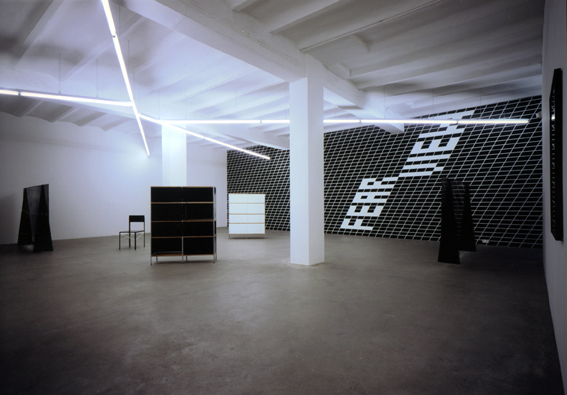
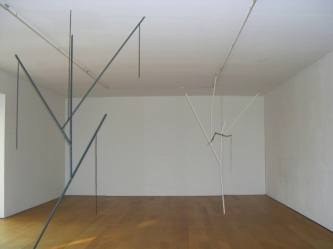

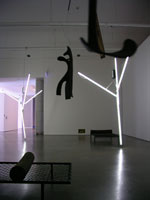
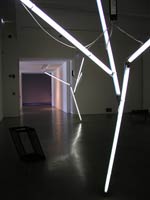

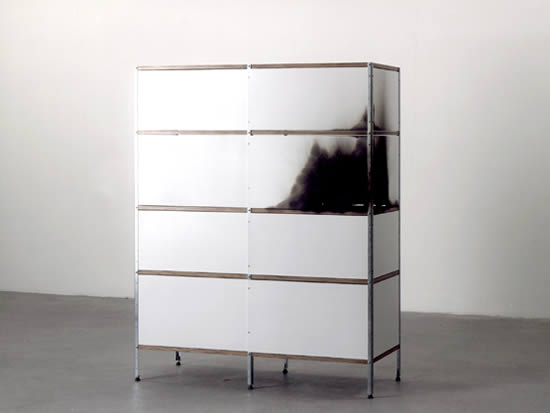
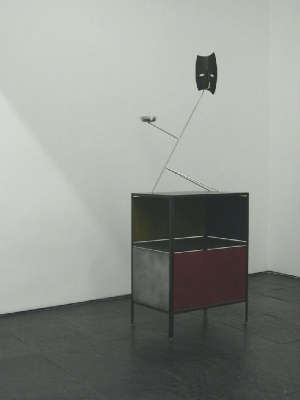
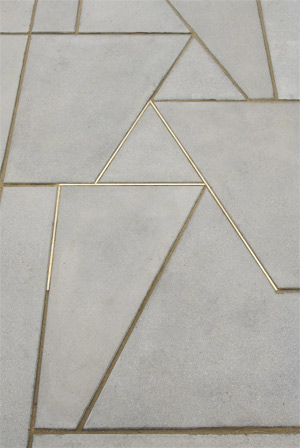
*1967 in Glasgow, lives and works in Glasgow and Berlin
出生于英国格拉斯哥,居住并工作于格拉斯哥和柏林
Martin Boyce 的作品内容在设计、建筑设计与日常生活的界面里。Boyce 关注物品的形式和作用而分析它们的概念。他参加了2003年里昂双年展,而获得Adolf Luther 基金会的艺术奖。他放弃了现代设计。在他作品里异常环境呈现。他作品"Fragile Landscapes" (脆弱风景)反应艺术家对设计的兴趣。他关注风景的概念,包括“断开或幻想的风景,普通的和原型的场景。他通过局部和细节描述这些风景。Boyce 说:“一个细节可以创建一个幻想适合居住的地方”。他作品内容也包含风景的建造和拆毁。
他参加了以下展览:
“如果不它不存在的话你就应该首创它”,2006年4月-5月,伦敦
Again for tomorrow, 2006年3月-4月,伦敦
Optik schroder, 2006年3月-4月,Kunstverein Brunswick
Punching through the clouds, 2006年1月-2月,纽约
Body, 2005年11月-2006年2月,美国
"Street: Behind the Cliché", Witte de With, Rotterdam 荷兰
"Electric Trees and Telephone Booth Conversations", FRAC des Pays de la Loire, Carquefou, 法国
"Dark Reflections", Adolf Luther Prize, Kaiser-Wilhelm-Museum, Krefeld,德国
"Our love is like the flowers, the rain, the sea and the hours" Tramway, Glasgow,英国
"For 1959 Capital Avenue", Museum für Moderne Kunst, Frankfurt,德国
展览作品
[attachment=46542]
Martin Boyce: We are still and reflective (Foto: Roman Mensing/sp07)
Martin Boyce works at the interface of design, architecture and daily life. Boyce addresses himself to the form and function of designed objects and analyses their concepts. He fundamentally disturbs the very substance of the works of Arne Jacobsen, Mies van der Rohe, and Charles and Ray Eames. He reinterprets and develops them further. Boyce, who participated in the Lyon Biennale of 2003 and received the Art Award of the Adolf Luther Foundation in Krefeld, abandons the modernist design. Disconcerting and strange environments come into being. Boyce's "fragile landscapes" underline the artist's interest in styling and design, which profoundly determine the human habitat and life. Boyce reflects the idea of landscape, including "fragmented or imaginary landscapes, generic and archetypical sites. These landscapes are often described through details and fragments." One detail, says Boyce, can "create an imaginary and habitable place". Even though the artist changes only a minor detail of the modernist classics of design, he is working on the construction and deconstruction of landscape.
Boyce's works could/can be seen in the following exhibitions:
„If it didn’t exist you’d have to invent it“, April/May 2006, The Showroom, London
„Again for tomorrow”, March/April 2006, Royal College of Art, London
„Optik Schröder“, March/April 2006, Kunstverein Brunswick
„Punching through the clouds“, January/February 2006, Tanya Bonakdar Gallery, New York
„Body“, November 2005-February 2006, Ottawa Art Gallery
"Street: Behind the Cliché", Witte de With, Rotterdam
"Electric Trees and Telephone Booth Conversations", FRAC des Pays de la Loire, Carquefou, Frankreich
"Dark Reflections", Adolf Luther Prize, Kaiser-Wilhelm-Museum, Krefeld
"Our love is like the flowers, the rain, the sea and the hours" Tramway, Glasgow
"For 1959 Capital Avenue", Museum für Moderne Kunst, Frankfurt
过往作品
[attachment=45151]
fear view, 2000, installation
[attachment=45152]
into this shadow, 2005
[attachment=45153]
[attachment=45154]
our love is like the earth, the rain, the trees and the birth, 2003
[attachment=45155]
our love is like the earth, the rain, the trees and the birth, 2003
[attachment=45156]
our love is like the earth, the rain, the trees and the birth, 2003
[attachment=45157]
white disaster, 2000
[attachment=45158]










Jeremy Deller
* 1966, London, lives and works in London
出生于1966年在英国伦敦,居住并工作于伦敦
自从1990年代,Jeremy Dellor 当过策划人、总见和编辑人,而发起了许多艺术计划和合作,让他了解历史、社会和地理方面的主题。Deller 主要对边远活动。他作品关注1980年代末英国历史和文化方面的身份。通过新造的历史背景,他创造新的透视和视觉。
他通过新闻和文化的研究方法考察,访问和分析一些问题。Deller的工作方式把他的作品放在公开的领域。通过颠覆性的介入,比如牌子或海报,他把一些活动、游行、文化传统、和不同的社会团体集合在一起。"The Battle of Orgreave" (Orgreave 的战斗),2001年属于Deller的主要作品。这个战斗的内容是关于1984年-1985年的矿工罢工。这个战斗变成工会和英国政府的权利奋斗。
Jeremy Deller 让一些矿工和爱好者再次展现撒切尔主义(Thatcherism)的主要事件,而用一个通俗的英国方式:历史事件的再次展现。2004年,艺术家作品"Memoery Bucket" 获得Turner Prize将。这个录像是Deller在德克萨斯州的旅游记录。艺术家当时从Waco出发:1993年Davidians邪教的80个会员在这个城市里被宣称为“恐怖分子”,几个星期的po.lice围困之后他们都被杀了。艺术家从这个城市开刀Crawford: 不慎的老家。
Deller 参加了以下展览:
"Breaking Step", 24. Mar. - 10. Jun. 2007, Belgrad Museum of Modern Art,贝尔格菜德现代美术馆
"4. berlin biennale 2006", March - June 2006,柏林双年展
"Whitney Biennale 2006", March - May 2006, Whitney Museum, New York,纽约
"Making History", Feb. - Apr. 2006, Tate Liverpool,泰特美术馆,英国
"Jeremy Deller Retrospektive", Oct. - Nov. 2005, Kunstverein München 德国
"Folk Archive", Oct. - Nov. 2005, Kunsthalle Basel 巴塞尔
"Jeremy Deller", May - Aug. 2005, BAWAG Foundation, Vienna 维也纳
"Populism", May - Sep. 2005, Kunstverein Frankfurt 德国
"Turner Prize 2004" , Oct. - Dez. 2004, Turner Prize, London, 2004年特纳奖,伦敦
展览作品
[attachment=46543]
Jeremy Deller: Speak to the Earth and It Will Tell You (Foto: Roman Mensing/sp07)
[attachment=46544]
Jeremy Deller: Speak to the Earth and It Will Tell You (Foto: Roman Mensing/sp07)
Since the mid-1990s, Jeremy Deller has been a mediator, curator, director, and publisher. As such, he has initiated a number of art projects and co-operations, which have enabled him to handle historical, social, and geographical themes in his authentic way. Deller is particularly interested in activities at the margins of the mainstream. His works focus on the history and cultural identity of the UK in the late 1980s. Through the re-contextualisation of recent history, Deller creates new perspectives, from which to re-view entrenched perceptions. He uses journalistic and cultural research methods, investigating, interviewing, and analysing. Deller's artistic practice, the performing and participating approach, used in his projects, place this artist's work in the public sphere. Through subversive intervention, e.g. pamphlets, signs, and posters, the manipulation of events, staged demonstrations, varying cultural traditions, different social groups are brought together in accordance with their respective logic. "The Battle of Orgreave", produced in 2001, won Deller international acclaim. "The Battle" is based on the legendary miners' strike of 1984/85, which, in the end, became a power struggle between trade unions and the British government. Jeremy Deller had former miners and amateurs re-enact the key event of Thatcherism, thereby, using a very popular English method – the re-enactment of historical events. In 2004, the artist received the prestigious Turner Prize for "Memory Bucket". This filmed diary is a documentary on Deller's trip through Texas. Beginning in Waco – where, in 1993, more than 80 members of the Davidians sect, declared "terrorists," were killed, following weeks of a police siege, under still unclear circumstances – he continued on to Crawford, the home of US President George W. Bush.
Deller's works could/can be seen in the following exhibitions:
"Breaking Step", 24. Mar. - 10. Jun. 2007, Belgrad Museum of Modern Art
"4. berlin biennale 2006", March - June 2006
"Whitney Biennale 2006", March - May 2006, Whitney Museum, New York
"Making History", Feb. - Apr. 2006, Tate Liverpool
"Jeremy Deller Retrospektive", Oct. - Nov. 2005, Kunstverein München
"Folk Archive", Oct. - Nov. 2005, Kunsthalle Basel
"Jeremy Deller", May - Aug. 2005, BAWAG Foundation, Vienna
"Populism", May - Sep. 2005, Kunstverein Frankfurt
"Turner Prize 2004", Oct. - Dez. 2004, Turner Prize, London
过往作品
[attachment=45159]
This is us, music from Appenzell, compiled by Jeremy Deller
[attachment=45160]
Memory bucket, 2003
[attachment=45161]
Memory bucket, 2003
[attachment=45162] ]
2004
[attachment=45163]
history of the world, 1997-2004
世界的历史,1997-2004
[attachment=45164]
history of the world, 1997-2004
世界的历史,1997-2004
[attachment=45165]
Battle of Orgreave, 2001
[attachment=45166]
Battle of Orgreave, 2001
[attachment=45197]
Battle of Orgreave, 2001
[attachment=45196]
untitled (bag), 2003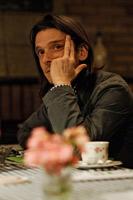
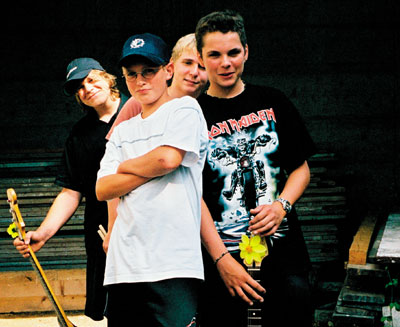
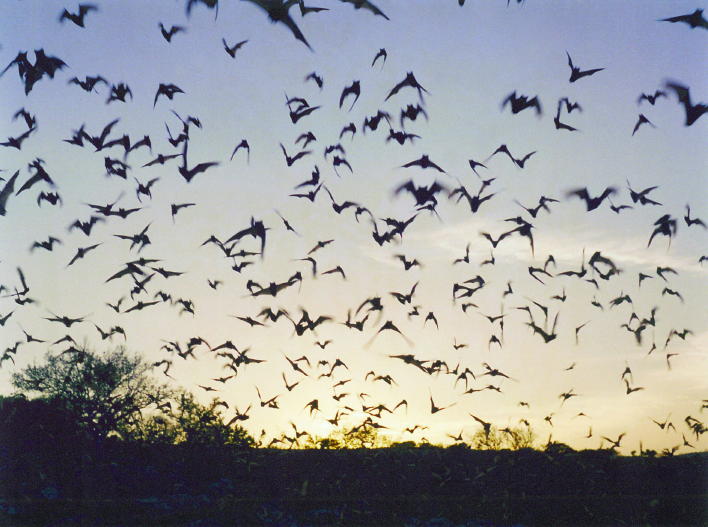
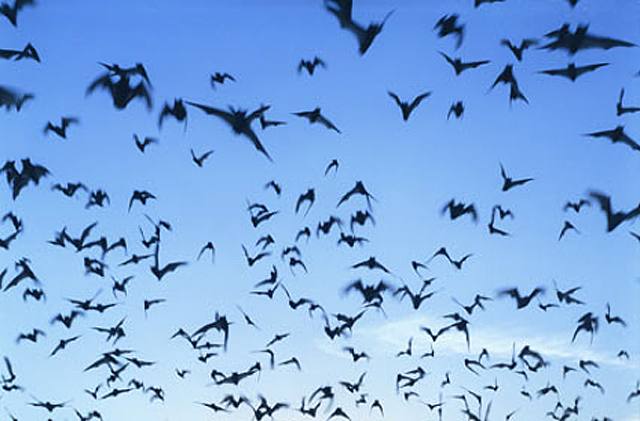
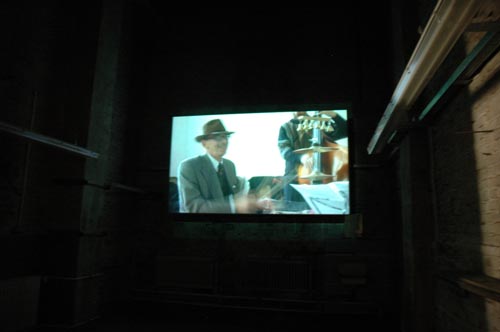
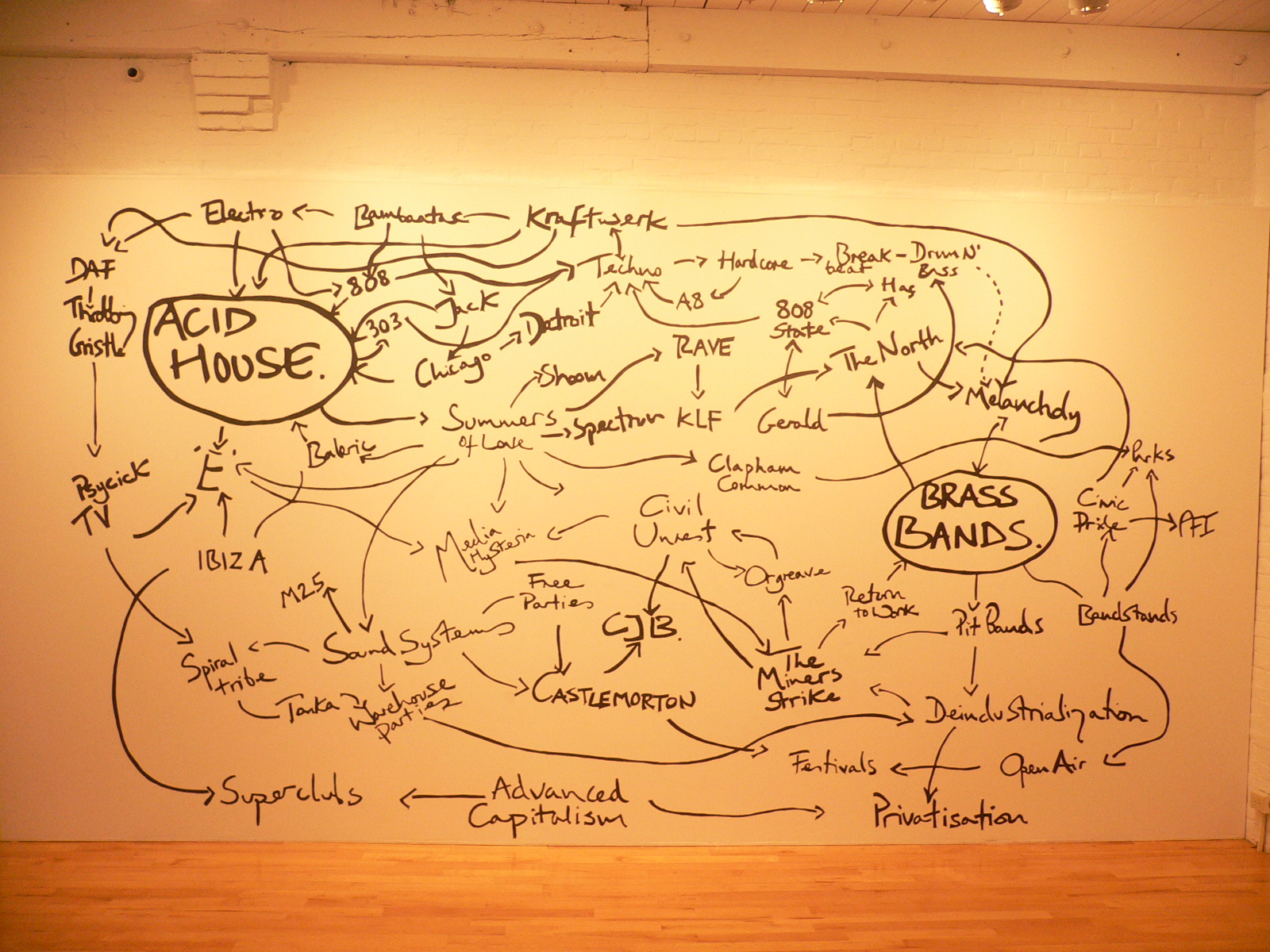
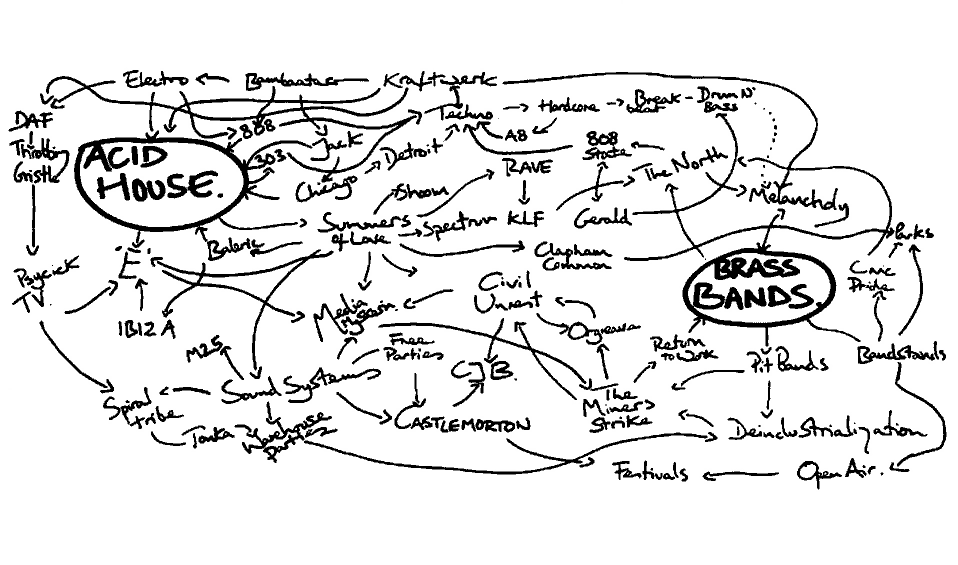
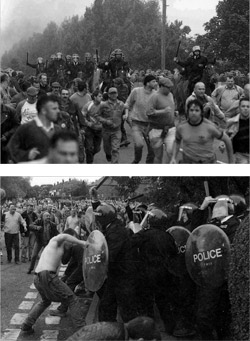
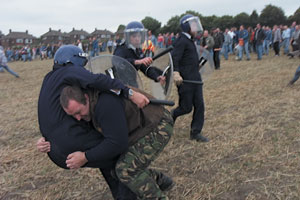
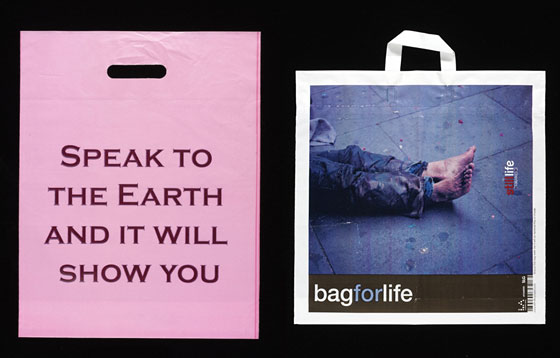
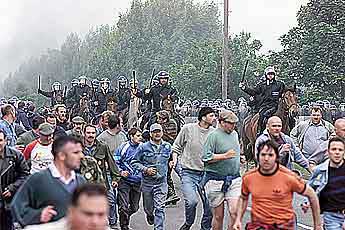

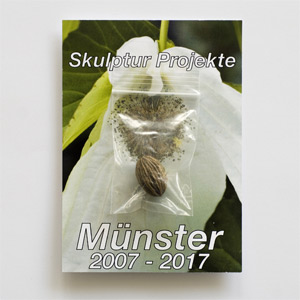
* 1966, London, lives and works in London
出生于1966年在英国伦敦,居住并工作于伦敦
自从1990年代,Jeremy Dellor 当过策划人、总见和编辑人,而发起了许多艺术计划和合作,让他了解历史、社会和地理方面的主题。Deller 主要对边远活动。他作品关注1980年代末英国历史和文化方面的身份。通过新造的历史背景,他创造新的透视和视觉。
他通过新闻和文化的研究方法考察,访问和分析一些问题。Deller的工作方式把他的作品放在公开的领域。通过颠覆性的介入,比如牌子或海报,他把一些活动、游行、文化传统、和不同的社会团体集合在一起。"The Battle of Orgreave" (Orgreave 的战斗),2001年属于Deller的主要作品。这个战斗的内容是关于1984年-1985年的矿工罢工。这个战斗变成工会和英国政府的权利奋斗。
Jeremy Deller 让一些矿工和爱好者再次展现撒切尔主义(Thatcherism)的主要事件,而用一个通俗的英国方式:历史事件的再次展现。2004年,艺术家作品"Memoery Bucket" 获得Turner Prize将。这个录像是Deller在德克萨斯州的旅游记录。艺术家当时从Waco出发:1993年Davidians邪教的80个会员在这个城市里被宣称为“恐怖分子”,几个星期的po.lice围困之后他们都被杀了。艺术家从这个城市开刀Crawford: 不慎的老家。
Deller 参加了以下展览:
"Breaking Step", 24. Mar. - 10. Jun. 2007, Belgrad Museum of Modern Art,贝尔格菜德现代美术馆
"4. berlin biennale 2006", March - June 2006,柏林双年展
"Whitney Biennale 2006", March - May 2006, Whitney Museum, New York,纽约
"Making History", Feb. - Apr. 2006, Tate Liverpool,泰特美术馆,英国
"Jeremy Deller Retrospektive", Oct. - Nov. 2005, Kunstverein München 德国
"Folk Archive", Oct. - Nov. 2005, Kunsthalle Basel 巴塞尔
"Jeremy Deller", May - Aug. 2005, BAWAG Foundation, Vienna 维也纳
"Populism", May - Sep. 2005, Kunstverein Frankfurt 德国
"Turner Prize 2004" , Oct. - Dez. 2004, Turner Prize, London, 2004年特纳奖,伦敦
展览作品
[attachment=46543]
Jeremy Deller: Speak to the Earth and It Will Tell You (Foto: Roman Mensing/sp07)
[attachment=46544]
Jeremy Deller: Speak to the Earth and It Will Tell You (Foto: Roman Mensing/sp07)
Since the mid-1990s, Jeremy Deller has been a mediator, curator, director, and publisher. As such, he has initiated a number of art projects and co-operations, which have enabled him to handle historical, social, and geographical themes in his authentic way. Deller is particularly interested in activities at the margins of the mainstream. His works focus on the history and cultural identity of the UK in the late 1980s. Through the re-contextualisation of recent history, Deller creates new perspectives, from which to re-view entrenched perceptions. He uses journalistic and cultural research methods, investigating, interviewing, and analysing. Deller's artistic practice, the performing and participating approach, used in his projects, place this artist's work in the public sphere. Through subversive intervention, e.g. pamphlets, signs, and posters, the manipulation of events, staged demonstrations, varying cultural traditions, different social groups are brought together in accordance with their respective logic. "The Battle of Orgreave", produced in 2001, won Deller international acclaim. "The Battle" is based on the legendary miners' strike of 1984/85, which, in the end, became a power struggle between trade unions and the British government. Jeremy Deller had former miners and amateurs re-enact the key event of Thatcherism, thereby, using a very popular English method – the re-enactment of historical events. In 2004, the artist received the prestigious Turner Prize for "Memory Bucket". This filmed diary is a documentary on Deller's trip through Texas. Beginning in Waco – where, in 1993, more than 80 members of the Davidians sect, declared "terrorists," were killed, following weeks of a police siege, under still unclear circumstances – he continued on to Crawford, the home of US President George W. Bush.
Deller's works could/can be seen in the following exhibitions:
"Breaking Step", 24. Mar. - 10. Jun. 2007, Belgrad Museum of Modern Art
"4. berlin biennale 2006", March - June 2006
"Whitney Biennale 2006", March - May 2006, Whitney Museum, New York
"Making History", Feb. - Apr. 2006, Tate Liverpool
"Jeremy Deller Retrospektive", Oct. - Nov. 2005, Kunstverein München
"Folk Archive", Oct. - Nov. 2005, Kunsthalle Basel
"Jeremy Deller", May - Aug. 2005, BAWAG Foundation, Vienna
"Populism", May - Sep. 2005, Kunstverein Frankfurt
"Turner Prize 2004", Oct. - Dez. 2004, Turner Prize, London
过往作品
[attachment=45159]
This is us, music from Appenzell, compiled by Jeremy Deller
[attachment=45160]
Memory bucket, 2003
[attachment=45161]
Memory bucket, 2003
[attachment=45162] ]
2004
[attachment=45163]
history of the world, 1997-2004
世界的历史,1997-2004
[attachment=45164]
history of the world, 1997-2004
世界的历史,1997-2004
[attachment=45165]
Battle of Orgreave, 2001
[attachment=45166]
Battle of Orgreave, 2001
[attachment=45197]
Battle of Orgreave, 2001
[attachment=45196]
untitled (bag), 2003













Michael Elmgreen
* 1961 Kopenhagen, Denmark
出生于1961年在丹麦
Ingar Dragset
* 1969 Trondheim, Norway
出生于1969年在挪威
The artists live and work in Berlin
居住并工作于柏林
自1995 年起 Michael Elmgreen 和 Ingar Dragset 便一起制作大批的装置,表演, 环境等作品。在一系列名叫 ‘无能结构’的创作里,他们面对了关于对空间感知的常规挑战:建筑学和社会结构在这里被潜在的日常欲望包括对墙,天花板,入口和出口和机制意识形态重组。这系列中的作品应付的是对不同公共领域的空间条件改变:城市环境和公共结构上的建筑。
--> 请看超级资料!!!!
展览作品
[attachment=46546]
Elmgreen & Dragset: Drama Queens (Rendering: sp07)
[attachment=46547]
Elmgreen & Dragset: Drama Queens (Rendering: sp07)
Powerless Structures have, over the past few years, made Michael Elmgreen and Ingar Dragset internationally acclaimed artists. Their works meet the categories of art, architecture and design. In installations and performances, this duo explores and redefines space and its numerous possibilities of definition and function. Their approach is based on Foucault's thesis, that it is the acceptance of certain behavioural patterns, within given structures, and not the structures, themselves, that restricts human action and activity. Elmgreen & Dragset transfer space to new contexts of description, purposefully modifying its functionality, and, therefore, facilitating the re-definition of the familiar. In 2003, the artists set up a Prada Store in the Texas desert, somewhere between Marfa and the hamlet of Valentine. Even though the shop displays the latest autumn collection of this international fashion trademark, the building had neither entrance nor exit, and slowly deteriorated. The Prada project is an example of the artists' works, which often allude to discussions about the White Cube. Michael Elmgreen and Ingar Dragset follow a traditional trend in art, which discusses the premises and reception of art, challenges the site of contemporary art, and finally, in the late 1980s and '90s, led to the criticism of the institutions.
Elmgreen's and Dragset's works could/can be seen in the following exhibitions:
„Protections“ (steirischer herbst 06), Sept-Oct. 2006, Kunsthaus Graz
„Gruppentherapie“, Sept. 2006-Jan. 2007, Museion, Bolzano
„7th East Wing collection – Culture Bound”, Jan. 06-2007, Courtauld Institute of Art, London
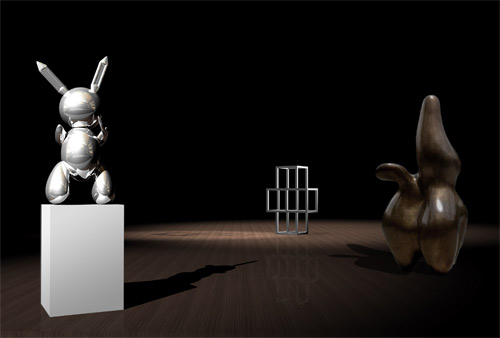

* 1961 Kopenhagen, Denmark
出生于1961年在丹麦
Ingar Dragset
* 1969 Trondheim, Norway
出生于1969年在挪威
The artists live and work in Berlin
居住并工作于柏林
自1995 年起 Michael Elmgreen 和 Ingar Dragset 便一起制作大批的装置,表演, 环境等作品。在一系列名叫 ‘无能结构’的创作里,他们面对了关于对空间感知的常规挑战:建筑学和社会结构在这里被潜在的日常欲望包括对墙,天花板,入口和出口和机制意识形态重组。这系列中的作品应付的是对不同公共领域的空间条件改变:城市环境和公共结构上的建筑。
--> 请看超级资料!!!!
展览作品
[attachment=46546]
Elmgreen & Dragset: Drama Queens (Rendering: sp07)
[attachment=46547]
Elmgreen & Dragset: Drama Queens (Rendering: sp07)
Powerless Structures have, over the past few years, made Michael Elmgreen and Ingar Dragset internationally acclaimed artists. Their works meet the categories of art, architecture and design. In installations and performances, this duo explores and redefines space and its numerous possibilities of definition and function. Their approach is based on Foucault's thesis, that it is the acceptance of certain behavioural patterns, within given structures, and not the structures, themselves, that restricts human action and activity. Elmgreen & Dragset transfer space to new contexts of description, purposefully modifying its functionality, and, therefore, facilitating the re-definition of the familiar. In 2003, the artists set up a Prada Store in the Texas desert, somewhere between Marfa and the hamlet of Valentine. Even though the shop displays the latest autumn collection of this international fashion trademark, the building had neither entrance nor exit, and slowly deteriorated. The Prada project is an example of the artists' works, which often allude to discussions about the White Cube. Michael Elmgreen and Ingar Dragset follow a traditional trend in art, which discusses the premises and reception of art, challenges the site of contemporary art, and finally, in the late 1980s and '90s, led to the criticism of the institutions.
Elmgreen's and Dragset's works could/can be seen in the following exhibitions:
„Protections“ (steirischer herbst 06), Sept-Oct. 2006, Kunsthaus Graz
„Gruppentherapie“, Sept. 2006-Jan. 2007, Museion, Bolzano
„7th East Wing collection – Culture Bound”, Jan. 06-2007, Courtauld Institute of Art, London



Hans-Peter Feldmann
*1941 in Hilden, lives and works in Düsseldorf
出生于1941年在Hilden, 居住并工作于德国杜塞尔多夫
对Hans-Peter Feldmann 来说,艺术是一个空间和事件的产品。所以他作品主要关注一些历史方面。Feldmann的艺术收集日常生活的物品、图片和摄影档案。他作品里主要用的材料为艺术明信片,裸体女的摄影,鞋子,报纸照片,日历,等等。这些构成过去到现在的类似体。他自己拍的黑白摄影通过一个浅薄的角度描述城市:楼,路,车,人……他收集摄影而做书。他的选举总结城市的情况和背景,而变成一个时代的图片。
过往展览:
gut ist was gefällt, January/February 2006, MMK Frankfurt 德国弗兰克福
„Hans-Peter Feldmann“, December 2005-April 2006, Kunsthalle Kiel,德国
Projekt Migration „Roadmap to Europe“, October 2005-January 2006, Kölnischer Kunstverein, 德国
„Covering the Real – Kunst und Pressebild“, May-Aug. 2005, Kunstmuseum Basel,巴塞尔
作品方案
[attachment=46545]
Hans-Peter Feldmann: WC-Anlage am Domplatz (Rendering: sp07)
在Domplatz广场上,教堂前面,剩下来了一些敏斯特的公共厕所。最近很多厕所都被拆掉。但是Domplatz 广场的地下厕所还在而被经常用。这个广场,每个星期三次有市场,周围有许多旅游点。Feldmann 的作品方案为重新装修这些洗手间,修改灯光。。。
Hans-Peter Feldmann is convinced that art is, a priori, the product of a certain time and place. He, therefore, works in a historical perspective, without, strictly speaking, being a historian. Feldmann's art is based on the collection and re-arrangement of the archive of photographs, pictures, and objects emanating from our daily lives. Artistic postcards, pictures of nude women, shoes, postcards of sunsets, newspaper photos, calendar pages etc. are the materials he uses. They form the basis of the analogies he recounts and presents to us. His own black and white photographs seem to refer to cities in a rather trivial approach: the urban arrangement of buildings, streets, cars, and people. Like a self-commissioned fieldworker, Feldmann compiles photographs into books. His anthologies summarise the circumstances and conditions in particular cities, and become pictures of a particular period. Feldmann plans to pursue a spatial concept in Münster in 2007.
Feldmann's works could/can be seen in the following exhibitions:
„gut ist was gefällt“, January/February 2006, MMK Frankfurt
„Hans-Peter Feldmann“, December 2005-April 2006, Kunsthalle Kiel
Projekt Migration „Roadmap to Europe“, October 2005-January 2006, Kölnischer Kunstverein
„Covering the Real – Kunst und Pressebild“, May-Aug. 2005, Kunstmuseum Basel
Project Description
On the Domplatz square, in front of the cathedral, there are still some of Münster's remaining public toilets, like those common to many cities in the past. In the meantime, most of these "public conveniences" have been eliminated from the urban landscape. But the underground toilets at the Domplatz have survived and are heavily frequented. Here on the square, an outdoor market takes place three times a week, tourist sites are in the vicinity, bus stops are located around the square, the post office and other public buildings are also nearby. The ill repair of these public toilets, is the point of departure for the artist Hans-Peter Feldmann and his project: He wants to refurbish and renovate these facilities, to prevent a large number of visitors from making negative aesthetic experiences. Feldmann sees his contribution to the sculpture projects münster 07 as a service to the public at large. The artist will redesign the restrooms, improve the lighting system, and offer the toilet service free of charge (currently users have to pay).
[attachment=45212]
Alles Kleider Ein Frau, 1974
[attachment=45213]
Die Bruecke 桥, 1974
[attachment=45214]
Tod, 死忙
[attachment=45215]
From Das Kleine Mowenbuch, 1979
[attachment=45216]
Hans Peter Feldmann, 4 bilder, 5 bilder, 6 bilder
[attachment=45218]
8 months, 8个月
[attachment=45219]
Newspaper Reader, 1998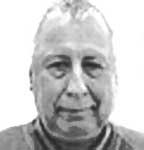

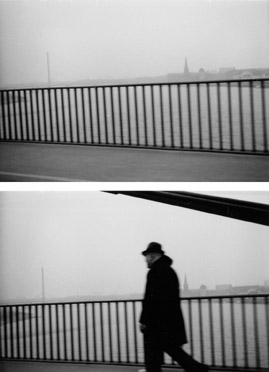


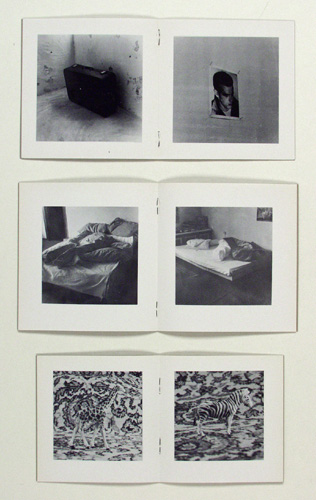
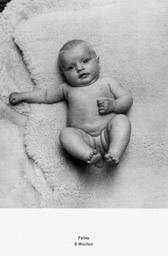
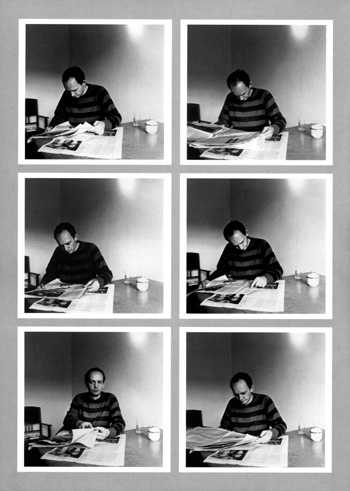
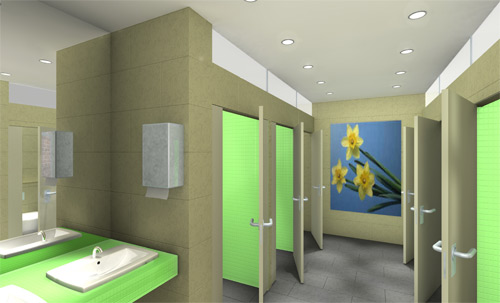
*1941 in Hilden, lives and works in Düsseldorf
出生于1941年在Hilden, 居住并工作于德国杜塞尔多夫
对Hans-Peter Feldmann 来说,艺术是一个空间和事件的产品。所以他作品主要关注一些历史方面。Feldmann的艺术收集日常生活的物品、图片和摄影档案。他作品里主要用的材料为艺术明信片,裸体女的摄影,鞋子,报纸照片,日历,等等。这些构成过去到现在的类似体。他自己拍的黑白摄影通过一个浅薄的角度描述城市:楼,路,车,人……他收集摄影而做书。他的选举总结城市的情况和背景,而变成一个时代的图片。
过往展览:
gut ist was gefällt, January/February 2006, MMK Frankfurt 德国弗兰克福
„Hans-Peter Feldmann“, December 2005-April 2006, Kunsthalle Kiel,德国
Projekt Migration „Roadmap to Europe“, October 2005-January 2006, Kölnischer Kunstverein, 德国
„Covering the Real – Kunst und Pressebild“, May-Aug. 2005, Kunstmuseum Basel,巴塞尔
作品方案
[attachment=46545]
Hans-Peter Feldmann: WC-Anlage am Domplatz (Rendering: sp07)
在Domplatz广场上,教堂前面,剩下来了一些敏斯特的公共厕所。最近很多厕所都被拆掉。但是Domplatz 广场的地下厕所还在而被经常用。这个广场,每个星期三次有市场,周围有许多旅游点。Feldmann 的作品方案为重新装修这些洗手间,修改灯光。。。
Hans-Peter Feldmann is convinced that art is, a priori, the product of a certain time and place. He, therefore, works in a historical perspective, without, strictly speaking, being a historian. Feldmann's art is based on the collection and re-arrangement of the archive of photographs, pictures, and objects emanating from our daily lives. Artistic postcards, pictures of nude women, shoes, postcards of sunsets, newspaper photos, calendar pages etc. are the materials he uses. They form the basis of the analogies he recounts and presents to us. His own black and white photographs seem to refer to cities in a rather trivial approach: the urban arrangement of buildings, streets, cars, and people. Like a self-commissioned fieldworker, Feldmann compiles photographs into books. His anthologies summarise the circumstances and conditions in particular cities, and become pictures of a particular period. Feldmann plans to pursue a spatial concept in Münster in 2007.
Feldmann's works could/can be seen in the following exhibitions:
„gut ist was gefällt“, January/February 2006, MMK Frankfurt
„Hans-Peter Feldmann“, December 2005-April 2006, Kunsthalle Kiel
Projekt Migration „Roadmap to Europe“, October 2005-January 2006, Kölnischer Kunstverein
„Covering the Real – Kunst und Pressebild“, May-Aug. 2005, Kunstmuseum Basel
Project Description
On the Domplatz square, in front of the cathedral, there are still some of Münster's remaining public toilets, like those common to many cities in the past. In the meantime, most of these "public conveniences" have been eliminated from the urban landscape. But the underground toilets at the Domplatz have survived and are heavily frequented. Here on the square, an outdoor market takes place three times a week, tourist sites are in the vicinity, bus stops are located around the square, the post office and other public buildings are also nearby. The ill repair of these public toilets, is the point of departure for the artist Hans-Peter Feldmann and his project: He wants to refurbish and renovate these facilities, to prevent a large number of visitors from making negative aesthetic experiences. Feldmann sees his contribution to the sculpture projects münster 07 as a service to the public at large. The artist will redesign the restrooms, improve the lighting system, and offer the toilet service free of charge (currently users have to pay).
[attachment=45212]
Alles Kleider Ein Frau, 1974
[attachment=45213]
Die Bruecke 桥, 1974
[attachment=45214]
Tod, 死忙
[attachment=45215]
From Das Kleine Mowenbuch, 1979
[attachment=45216]
Hans Peter Feldmann, 4 bilder, 5 bilder, 6 bilder
[attachment=45218]
8 months, 8个月
[attachment=45219]
Newspaper Reader, 1998









[attachment=45926]
Zimmer, Gespräche Chambres,conversations2006
Dora Garcia
出生于西班牙Valladolid。居住和工作于比利时布鲁塞尔。
她在西班牙的Salamanca 美术学院及阿姆斯特丹的Rijksakademie学习了。她的作品包含绘画、摄影、装置、行为表演、录像、声音和网络艺术。Garcia 创造一些背景/情况来改变艺术家、作品和观众的传统关系。她的作品被美术馆、基金会收藏过(包括Henry Art 基金会,西班牙的 MACBA, 等等)。
她的作品关注缺席和隐形的概念:建筑和空间。她的行为表演因文学创作,暗示一种心理的和解。Garcia对在发展中的人类规则,经常提到社会情况以及多产的矛盾。她的作品不是关于不可能性的而是关于期待和期待的发展。她的作品提到现实和虚构的问题。
展览作品
[attachment=46548]
Dora Garcia: The Beggar's Opera
Dora García was born in Valladolid in Spain and for several years now. She has been living and working in Brussels. She studied Fine Arts at the University of Salamanca (Spain) and at the Rijksakademie in Amsterdam (The Netherlands). Her work comprises drawings, photography, installations, performance, video, sound and net.art. Garcia is interested in the creation of situations or contexts that serve to alter the traditional relationship between artist, artwork and spectator. Her work is included in numerous collections and museums (among them the Henry Art Foundation in Seattle, the MACBA in Barcelona as well as diverse private collections) and her video work has been shown, among other places, at Rotterdam's International Film Festival, the Museo Nacional Reina Sofía (Madrid) and De Brakke Grond (Amsterdam).
The work of Dora García plays on the notions of absence and invisibility: building and contemplating emptiness. It arises like an obstacle between the spectator and the image, the reader and the text and creates– an imaginary niche, which can only be reconstructed with the help of memory or the imagination. Her performances and videos, mostly drawn from literary sources, imply a mental compromise, a concept which results from subtraction rather than addition. García is mainly interested in the continuously evolving laws of human existence, with recurring themes like social conditioning and productive contradictions. Her work is not about impossibility, but about expectations and how they change. When approaching Dora García's practice one must begin to read the smallest signs as possible signifiers. Her work permanently confronts the question of what is fiction and what is real, thus the spectator becomes the inevitable protagonist of a fiction, sometimes knowingly, sometimes not.
过往作品:
[attachment=45916]
Burning Post-its, 2005
[attachment=45917]
Crowd 2004 人群
[attachment=45918]
Dj Los muertos, 1998, 综合媒体
[attachment=45919]
Fahrenheit 451, 2004
[attachment=45920]
Intolerable light, 2004
不可忍受的光,2004
[attachment=45921]
L'art est pour tous mais seule une elite le sait, 2006, paint
艺术是给大家看,但只有杰出的人知道,2006, 绘画
[attachment=45922]
La leccion respiratoria, 2001
[attachment=45923]
La maquina horizonte, 2001
[attachment=45924]
autres planetes, 2005
其他世界,2005
[attachment=45925]
oui ou non (le sphinx), 2005
[attachment=45927]
The locked room
[attachment=45928]
The glass wall 玻璃墙
[attachment=45929]
The messenger, 2006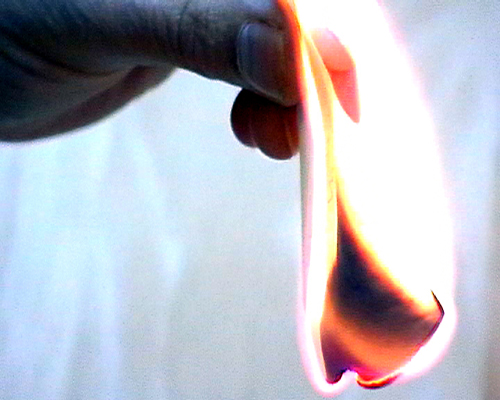

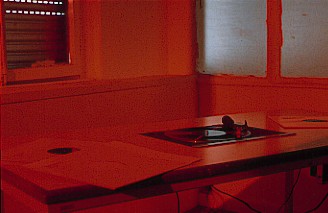
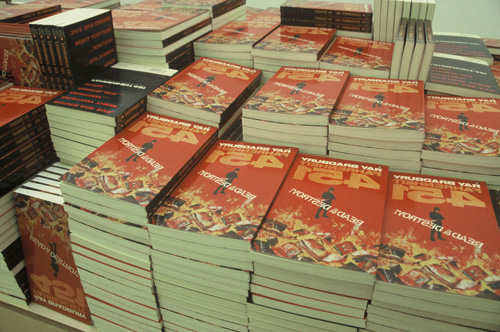
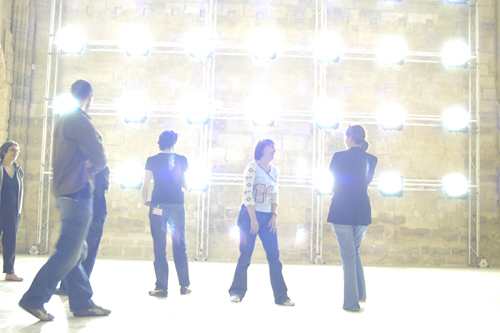
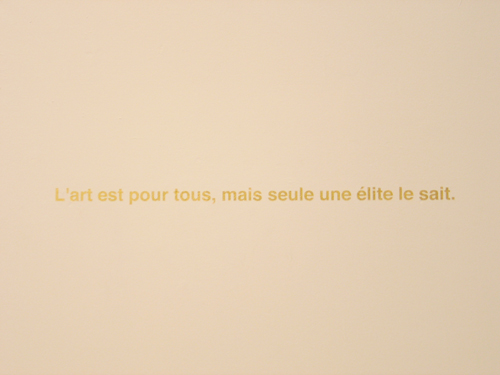
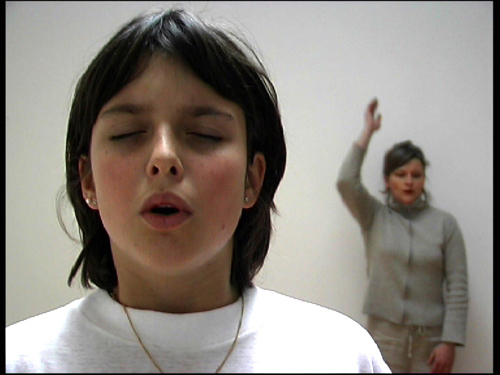
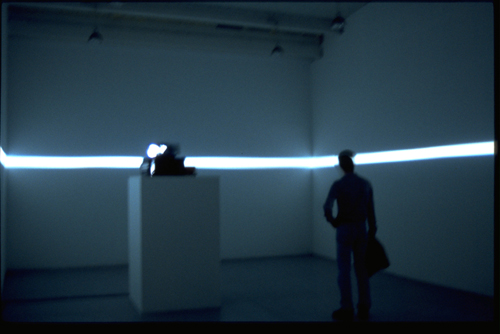
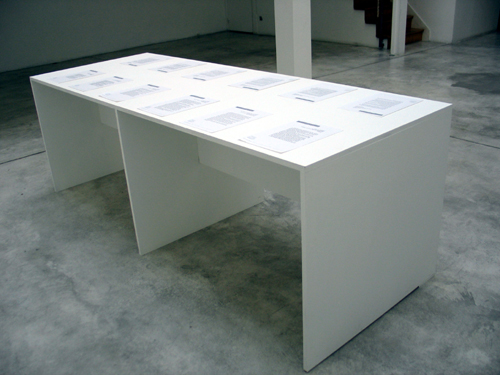
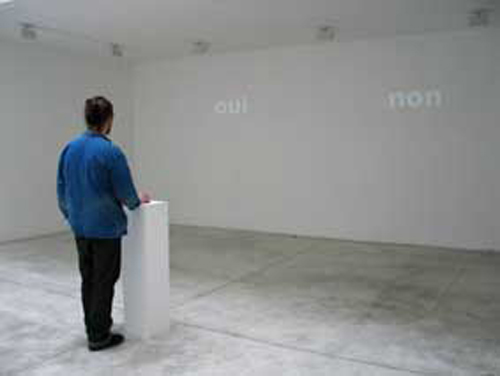
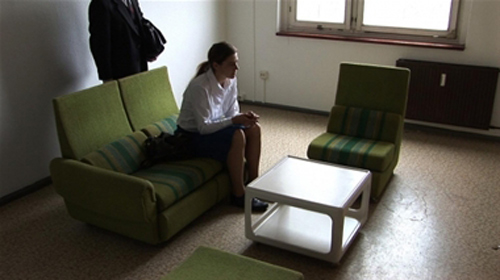

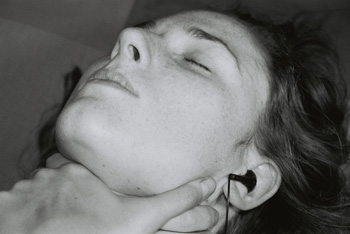
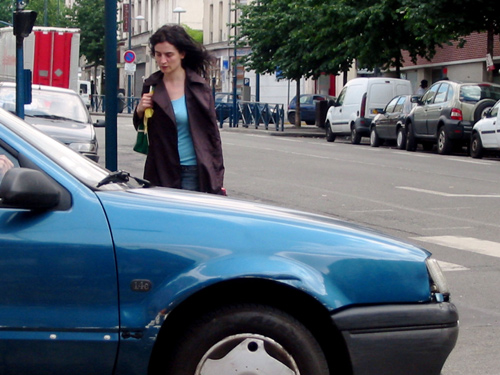
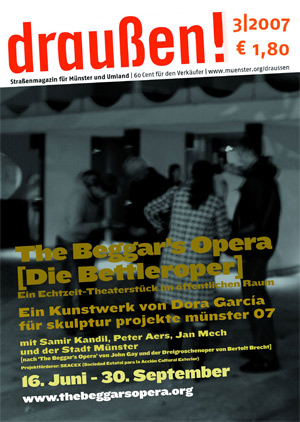
Zimmer, Gespräche Chambres,conversations2006
Dora Garcia
出生于西班牙Valladolid。居住和工作于比利时布鲁塞尔。
她在西班牙的Salamanca 美术学院及阿姆斯特丹的Rijksakademie学习了。她的作品包含绘画、摄影、装置、行为表演、录像、声音和网络艺术。Garcia 创造一些背景/情况来改变艺术家、作品和观众的传统关系。她的作品被美术馆、基金会收藏过(包括Henry Art 基金会,西班牙的 MACBA, 等等)。
她的作品关注缺席和隐形的概念:建筑和空间。她的行为表演因文学创作,暗示一种心理的和解。Garcia对在发展中的人类规则,经常提到社会情况以及多产的矛盾。她的作品不是关于不可能性的而是关于期待和期待的发展。她的作品提到现实和虚构的问题。
展览作品
[attachment=46548]
Dora Garcia: The Beggar's Opera
Dora García was born in Valladolid in Spain and for several years now. She has been living and working in Brussels. She studied Fine Arts at the University of Salamanca (Spain) and at the Rijksakademie in Amsterdam (The Netherlands). Her work comprises drawings, photography, installations, performance, video, sound and net.art. Garcia is interested in the creation of situations or contexts that serve to alter the traditional relationship between artist, artwork and spectator. Her work is included in numerous collections and museums (among them the Henry Art Foundation in Seattle, the MACBA in Barcelona as well as diverse private collections) and her video work has been shown, among other places, at Rotterdam's International Film Festival, the Museo Nacional Reina Sofía (Madrid) and De Brakke Grond (Amsterdam).
The work of Dora García plays on the notions of absence and invisibility: building and contemplating emptiness. It arises like an obstacle between the spectator and the image, the reader and the text and creates– an imaginary niche, which can only be reconstructed with the help of memory or the imagination. Her performances and videos, mostly drawn from literary sources, imply a mental compromise, a concept which results from subtraction rather than addition. García is mainly interested in the continuously evolving laws of human existence, with recurring themes like social conditioning and productive contradictions. Her work is not about impossibility, but about expectations and how they change. When approaching Dora García's practice one must begin to read the smallest signs as possible signifiers. Her work permanently confronts the question of what is fiction and what is real, thus the spectator becomes the inevitable protagonist of a fiction, sometimes knowingly, sometimes not.
过往作品:
[attachment=45916]
Burning Post-its, 2005
[attachment=45917]
Crowd 2004 人群
[attachment=45918]
Dj Los muertos, 1998, 综合媒体
[attachment=45919]
Fahrenheit 451, 2004
[attachment=45920]
Intolerable light, 2004
不可忍受的光,2004
[attachment=45921]
L'art est pour tous mais seule une elite le sait, 2006, paint
艺术是给大家看,但只有杰出的人知道,2006, 绘画
[attachment=45922]
La leccion respiratoria, 2001
[attachment=45923]
La maquina horizonte, 2001
[attachment=45924]
autres planetes, 2005
其他世界,2005
[attachment=45925]
oui ou non (le sphinx), 2005
[attachment=45927]
The locked room
[attachment=45928]
The glass wall 玻璃墙
[attachment=45929]
The messenger, 2006















[attachment=45974]
Untitled/无题, 2001
Isa Genzken
*1948, Bad Oldesloe, lives and works in Berlin
1948年生于Bad Oldesloe, 居住和工作于在德国柏林
Isa Genzken 参加过1987年和1997年的敏斯特10年展。她作品研究环境对人的影响。建筑设计、广告、设计和媒体影响人在公共空间里的态度。形式方面,她的作品主要为雕塑。她用的材料指定她的作品的临时感。她也用其他媒体包括摄影、录像、镜子、塑料纸和日常物品。她研究物品的本质而改造背景。
展览作品
[attachment=46549]
Isa Genzken: Ohne Titel (Foto: Roman Mensing/sp07)
[attachment=46550]
Isa Genzken: Ohne Titel (Foto: Roman Mensing/sp07)
Isa Genzken participated in the sculpture projects in 1987 and 1997. Her works explore the impact of the environment on us, and the effect it has. The tensions between architecture, advertising, design, and the media determine human behaviour in public space, and are the focus of Genzken's interest. In terms of form, her art is bound by an autonomous concept of art and sculpture. She often uses materials that underline the temporary character of her works. Genzken also employs the traditional media, i.e. photography, video, mirrors, plastic film, and everyday accessories. Her art establishes an immediate reference to the location: She tries to capture its nature and to transfer it into a new context.
Genzken's works could/can be seen in the following exhibitions:
„Genzken / Lamelas“, July-September 2006, Viennese Secession
„Isa Genzken“, June-August 2006, Galerie im Taxispalais, Innsbruck
„Optik Schröder“, March/April 2006, Kunstverein Brunswick
„Von Richter bis Scheibitz“, January-July 2006, Kunstmuseum Winterthur
„Bühne des Lebens – Rhetorik des Gefühls“, November 2005-July 2006, Lenbachhaus, Munich
„Occupying Space“, October-December 2005, Museum of Contemporary Art, Zagreb
过往作品:
[attachment=45970]
I love New York, Crazy / 我喜欢纽约,疯狂
[attachment=45971]
I love New York, Crazy / 我喜欢纽约,疯狂
[attachment=45972]
I love New York, Crazy / 我喜欢纽约,疯狂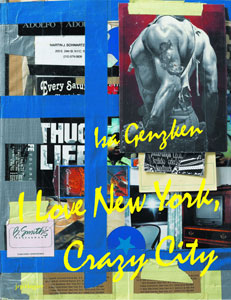
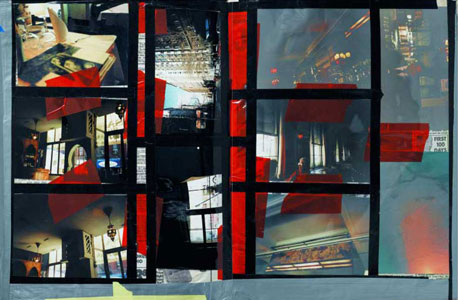
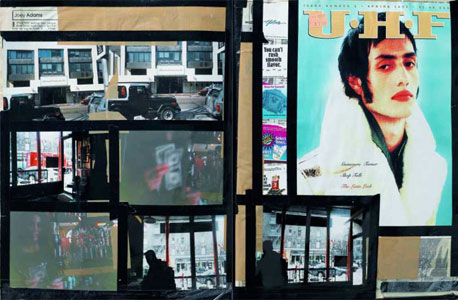

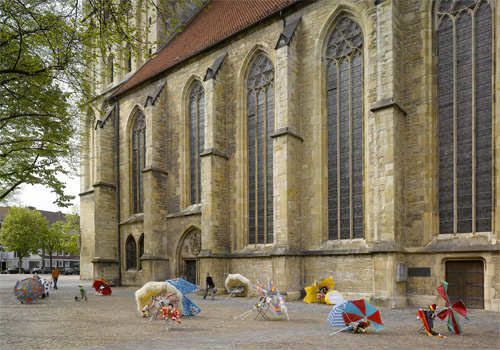
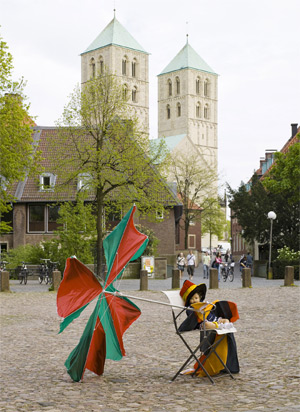
Untitled/无题, 2001
Isa Genzken
*1948, Bad Oldesloe, lives and works in Berlin
1948年生于Bad Oldesloe, 居住和工作于在德国柏林
Isa Genzken 参加过1987年和1997年的敏斯特10年展。她作品研究环境对人的影响。建筑设计、广告、设计和媒体影响人在公共空间里的态度。形式方面,她的作品主要为雕塑。她用的材料指定她的作品的临时感。她也用其他媒体包括摄影、录像、镜子、塑料纸和日常物品。她研究物品的本质而改造背景。
展览作品
[attachment=46549]
Isa Genzken: Ohne Titel (Foto: Roman Mensing/sp07)
[attachment=46550]
Isa Genzken: Ohne Titel (Foto: Roman Mensing/sp07)
Isa Genzken participated in the sculpture projects in 1987 and 1997. Her works explore the impact of the environment on us, and the effect it has. The tensions between architecture, advertising, design, and the media determine human behaviour in public space, and are the focus of Genzken's interest. In terms of form, her art is bound by an autonomous concept of art and sculpture. She often uses materials that underline the temporary character of her works. Genzken also employs the traditional media, i.e. photography, video, mirrors, plastic film, and everyday accessories. Her art establishes an immediate reference to the location: She tries to capture its nature and to transfer it into a new context.
Genzken's works could/can be seen in the following exhibitions:
„Genzken / Lamelas“, July-September 2006, Viennese Secession
„Isa Genzken“, June-August 2006, Galerie im Taxispalais, Innsbruck
„Optik Schröder“, March/April 2006, Kunstverein Brunswick
„Von Richter bis Scheibitz“, January-July 2006, Kunstmuseum Winterthur
„Bühne des Lebens – Rhetorik des Gefühls“, November 2005-July 2006, Lenbachhaus, Munich
„Occupying Space“, October-December 2005, Museum of Contemporary Art, Zagreb
过往作品:
[attachment=45970]
I love New York, Crazy / 我喜欢纽约,疯狂
[attachment=45971]
I love New York, Crazy / 我喜欢纽约,疯狂
[attachment=45972]
I love New York, Crazy / 我喜欢纽约,疯狂






Dominique Gonzalez-Foerster
*1965 in Strasbourg,, France, lives and works in Paris and Rio de Janeiro
出生于1965年法国,居住和工作于法国巴黎和巴西约热内卢
Gonzaler Foerster 强调日常环境里的简短里的空间。在她的电影、录像、摄影和装置里她关注这些空间的美学方面。她关注地方、物品和使用者的关系。她在2002年的Documenta 11展览里展出了”花园 – 逃避的计划”。这个装置由60年代的还原建筑局部构成的,和一个录像。
Gonzaler Foersters参加了以下展览
« Raconte-moi / Tell me“, June-October 2006, Casino Luxembourg, Luxemburg
给我讲,2006年6月-10月,卢森堡
“Tropicália“, February-May 2006, Barbican Centre, London
热带的,2006年2月-3月,伦敦
“Cinemas“, January-May 2006, Le Magasin, Grenoble
电影,2006年1月-5月,法国
“Ambiance“, October 2005-January 2006, Kunstsammlung im St?ndehaus, Düsseldorf
气氛,2005年10月-2006年1月,德国
展览作品
[attachment=46551]
Dominique Gonzalez-Foerster: Roman de Münster (Foto: Roman Mensing/sp07)
[attachment=46552]
Dominique Gonzalez-Foerster: Roman de Münster (Foto: Roman Mensing/sp07)
Gonzalez-Foerster emphasises the transitory interspaces in our everyday environment. In her films, videos, photo series, and installations she focuses on their aesthetics, and goes beyond their potential dreariness. The artist is particularly interested in the establishing a meaningful relationship between place, object and the potential user. For documenta 11 she designed the "Park – A Plan for Escape" in the Karlsaue Park in Kassel in 2002. The installation consisted of fragments of the park and garden architecture of the 1960s: the typical lantern, a meandering path, a bench, a small pond made of concrete and painted blue, and a video projection hall, which served as an outside screen. Gonzalez-Foerster is interested in the aesthetic and action-oriented functionality of these fragments and rooms, which she re-enacts and interprets in her works.
Gonzalez-Foerster's works could/can be seen in the following exhibitions:
„Raconte-moi / Tell me“, June-October 2006, Casino Luxembourg, Luxemburg
„Tropicália“, February-May 2006, Barbican Centre, London
„Cinemas“, January-May 2006, Le Magasin, Grenoble
„Ambiance“, October 2005-January 2006, Kunstsammlung im Ständehaus, Düsseldorf
过往作品:
[attachment=45975]
[attachment=45976]
Cosmodrome, 2001
[attachment=45977]
Moment Dream House
[attachment=45978]
Plage 2001, 录像, 15 min
[attachment=45979]
Repulse Bay, 1999
[attachment=45980]
Seance de Shadow, 1999
[attachment=45981]


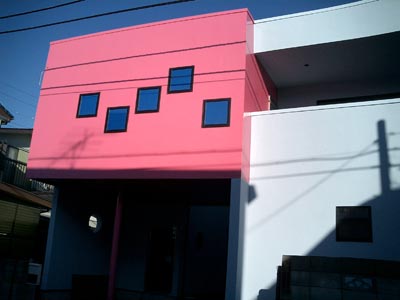

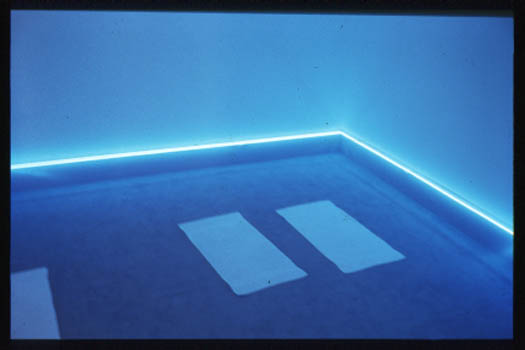

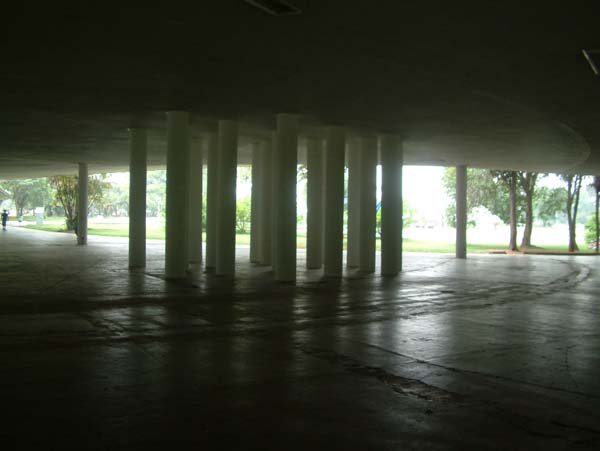
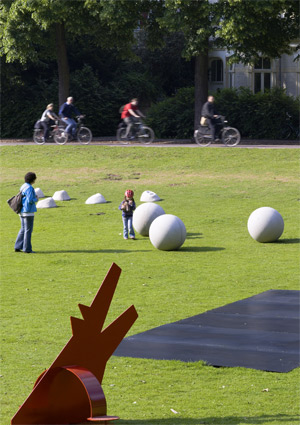
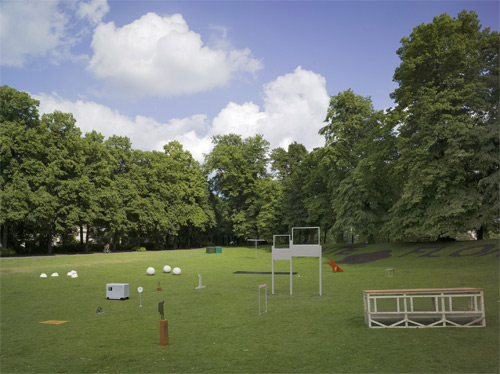
*1965 in Strasbourg,, France, lives and works in Paris and Rio de Janeiro
出生于1965年法国,居住和工作于法国巴黎和巴西约热内卢
Gonzaler Foerster 强调日常环境里的简短里的空间。在她的电影、录像、摄影和装置里她关注这些空间的美学方面。她关注地方、物品和使用者的关系。她在2002年的Documenta 11展览里展出了”花园 – 逃避的计划”。这个装置由60年代的还原建筑局部构成的,和一个录像。
Gonzaler Foersters参加了以下展览
« Raconte-moi / Tell me“, June-October 2006, Casino Luxembourg, Luxemburg
给我讲,2006年6月-10月,卢森堡
“Tropicália“, February-May 2006, Barbican Centre, London
热带的,2006年2月-3月,伦敦
“Cinemas“, January-May 2006, Le Magasin, Grenoble
电影,2006年1月-5月,法国
“Ambiance“, October 2005-January 2006, Kunstsammlung im St?ndehaus, Düsseldorf
气氛,2005年10月-2006年1月,德国
展览作品
[attachment=46551]
Dominique Gonzalez-Foerster: Roman de Münster (Foto: Roman Mensing/sp07)
[attachment=46552]
Dominique Gonzalez-Foerster: Roman de Münster (Foto: Roman Mensing/sp07)
Gonzalez-Foerster emphasises the transitory interspaces in our everyday environment. In her films, videos, photo series, and installations she focuses on their aesthetics, and goes beyond their potential dreariness. The artist is particularly interested in the establishing a meaningful relationship between place, object and the potential user. For documenta 11 she designed the "Park – A Plan for Escape" in the Karlsaue Park in Kassel in 2002. The installation consisted of fragments of the park and garden architecture of the 1960s: the typical lantern, a meandering path, a bench, a small pond made of concrete and painted blue, and a video projection hall, which served as an outside screen. Gonzalez-Foerster is interested in the aesthetic and action-oriented functionality of these fragments and rooms, which she re-enacts and interprets in her works.
Gonzalez-Foerster's works could/can be seen in the following exhibitions:
„Raconte-moi / Tell me“, June-October 2006, Casino Luxembourg, Luxemburg
„Tropicália“, February-May 2006, Barbican Centre, London
„Cinemas“, January-May 2006, Le Magasin, Grenoble
„Ambiance“, October 2005-January 2006, Kunstsammlung im Ständehaus, Düsseldorf
过往作品:
[attachment=45975]
[attachment=45976]
Cosmodrome, 2001
[attachment=45977]
Moment Dream House
[attachment=45978]
Plage 2001, 录像, 15 min
[attachment=45979]
Repulse Bay, 1999
[attachment=45980]
Seance de Shadow, 1999
[attachment=45981]










英文网????????????????????
看上去满有意思的 [s:318] [s:318] [s:337] [s:310]
吃<闻>我一撅,后果自负!
[attachment=45991]
Tue Greenfort
*1973 Holbæk / Dänemark, lives in Frankfurt and Berlin
生于1973年在丹麦,居住和工作于德国弗兰克福和柏林
Tue Greenfort 的作品主要为特定地点艺术。艺术家研究特殊的生态系统,不管是城市的或农村的。在他的作品,Social Organism (社会生物), 2001年,Greenfort 建造了一条小路给蚂蚁,让他们走到为他们做的一个菜。Greenfort 说 “我不研究自然像研究一个外面的现象,我跟一个带其它生物的空间(环境)玩以及互动”
展览作品
[attachment=46553]
Tue Greenfort: Diffuse Einträge (Skizze: Tue Greenfort)
[attachment=46554]
Tue Greenfort: Diffuse Einträge (Foto: Thorsten Arendt/sp07)
Tue Greenfort's work invariably takes a site-specific approach, enabling the artist to examine particular eco-systems, whether they be urban or rural. In his piece Social Organism, 2001, part of an investigation of animal habitats, Greenfort created a pathway for ants leading to a specially prepared meal. Daimerlerstrasse 38, 2001, adopted a similar conceptual process in which a camera was triggered by sausages left for foxes. Greenfort stated recently, 'I don't observe nature as an external phenomenon, but play and interact within a space - call it a habitat or a certain environment - where other organisms are present besides me.'
过往作品:
[attachment=45983]
Social Organism, 2001
[attachment=45984]
Used and Produced
[attachment=45985]
Used and Produced
[attachment=45986]
1.5 L PET water bottle transformed to a 0.5 L bottle and filled with local
[attachment=45987]
A flies composition, 2004
[attachment=45988]
Bow fly, 2005
[attachment=45989]
Ernst Sturm P&O Nedlloyd, c-print
[attachment=45990]
Fisherman in Ghana, 2005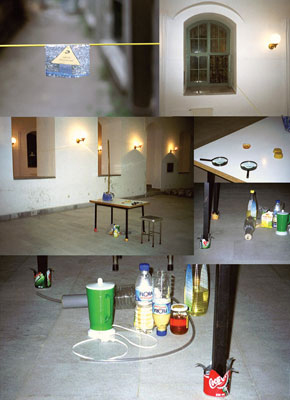
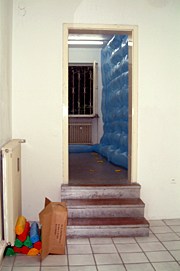


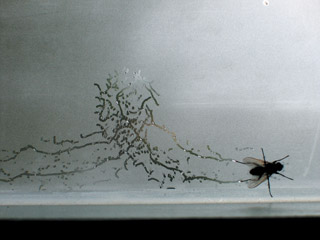

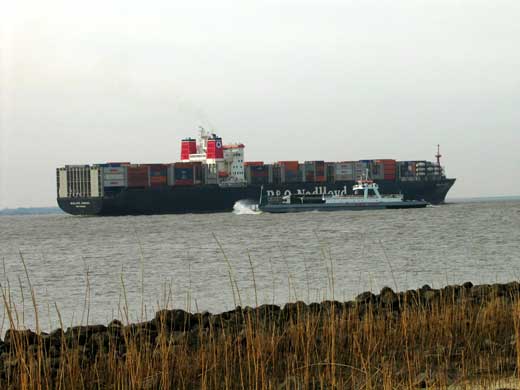
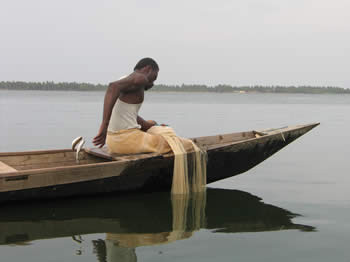
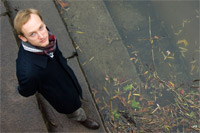
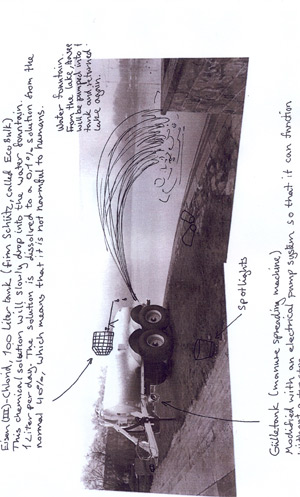

Tue Greenfort
*1973 Holbæk / Dänemark, lives in Frankfurt and Berlin
生于1973年在丹麦,居住和工作于德国弗兰克福和柏林
Tue Greenfort 的作品主要为特定地点艺术。艺术家研究特殊的生态系统,不管是城市的或农村的。在他的作品,Social Organism (社会生物), 2001年,Greenfort 建造了一条小路给蚂蚁,让他们走到为他们做的一个菜。Greenfort 说 “我不研究自然像研究一个外面的现象,我跟一个带其它生物的空间(环境)玩以及互动”
展览作品
[attachment=46553]
Tue Greenfort: Diffuse Einträge (Skizze: Tue Greenfort)
[attachment=46554]
Tue Greenfort: Diffuse Einträge (Foto: Thorsten Arendt/sp07)
Tue Greenfort's work invariably takes a site-specific approach, enabling the artist to examine particular eco-systems, whether they be urban or rural. In his piece Social Organism, 2001, part of an investigation of animal habitats, Greenfort created a pathway for ants leading to a specially prepared meal. Daimerlerstrasse 38, 2001, adopted a similar conceptual process in which a camera was triggered by sausages left for foxes. Greenfort stated recently, 'I don't observe nature as an external phenomenon, but play and interact within a space - call it a habitat or a certain environment - where other organisms are present besides me.'
过往作品:
[attachment=45983]
Social Organism, 2001
[attachment=45984]
Used and Produced
[attachment=45985]
Used and Produced
[attachment=45986]
1.5 L PET water bottle transformed to a 0.5 L bottle and filled with local
[attachment=45987]
A flies composition, 2004
[attachment=45988]
Bow fly, 2005
[attachment=45989]
Ernst Sturm P&O Nedlloyd, c-print
[attachment=45990]
Fisherman in Ghana, 2005











David Hammons
生于1943年在美国Springfield,居住和工作于纽约
David Hammons 善于制作影响大的小介入。“我做的越来越少,我就越来越是一个艺术家”。 他1983年在纽约做了一个行为叫“Bliz-aard Ball Sale”:他跟路上的小买方站在一起卖不同尺寸的雪球。他通过这个作品表达市场的一些规定:只要背景合适就可以麦任何东西,他在这里也批评艺术市场:什么都能卖包括毫无意义的物品。
Hammon的作品经常带讽刺感而比较刺激。他也喜欢在作品里放一些非洲传统的因素,不管是材料或感觉。
Hammon 参加过以下展览:
Hammons' works could/can be seen in the following exhibitions:
“2006年光州双年展“,2006年9月-11月,韩国
“黑豹阶级”,2006年3月-7月,三藩市
“洛杉矶 1955-1985”,2006 年2月-3月,蓬皮杜艺术中心,法国
“David Hammons: Phat Free”, 2006年2月-3月,美国
"Gwangju Biennale 2006", September-November 2006, Gwangju, South Korea
"Black Panther Rank and File", March-July 2006, Yerba Buena Center for the Arts, San Francisco
"Los Angeles 1955-1985", March-July 2006, Centre Pompidou, Paris
"David Hammons: Phat Free", Februar-May 2006, Saint Louis Art Museum, St. Louis
Biography
David Hammons is a master of minor artistic intervention that triggers major effects: "The less I do, the more artist I am." His performance, 'Bliz-aard Ball Sale' of 1983 on Cooper Square in New York is an excellent example to underline this statement. Standing between street vendors, Hammons offered snow balls, sorted by size, for sale. The artist wanted to illustrate that given the right setting, anything can be commercialized. This was also a reference to the art market, functioning along similar principals, where even seemingly senseless objects are given a price.
Like in this performance, that also uses urban experiences, Hammons' works generally contain a streak of irony, even sarcasm, which, at second glance, give his projects an aggressive air. For the artist it is also important to integrate African traditions into his work. This can be seen in either his choice of materials, or his preference of multi-colored patterns and spiritual aspects. The 'Rock Head' (2004), for example, is an oval boulder found in Harlem, upon which hair, swept from a Harlem barbershop floor, had been glued, then given a haircut by the same barber. Hammons, who participated at documenta in 1992 and at the Venice Biennale in 2003, takes a growing distance to the world of art. In spite of many invitations, he participates only in selected exhibits.
[attachment=46001]
African -American Flad, 1990
非洲-美国旗,1990
[attachment=46002]
B Ball, 1998, dirt on paper
[attachment=46003]
Basket ball installation, 1995
篮球装置,1995
[attachment=46004]
African Stand, 1991
[attachment=46005]
Free Mandela
[attachment=46006]
Champ, 1989
[attachment=46007]
1990
[attachment=46008]
How do they like us now, 1988
他们现在怎么喜欢我们,1988
[attachment=46009]
Injustice case, 1970
[attachment=46010]
This and That
这个和那个
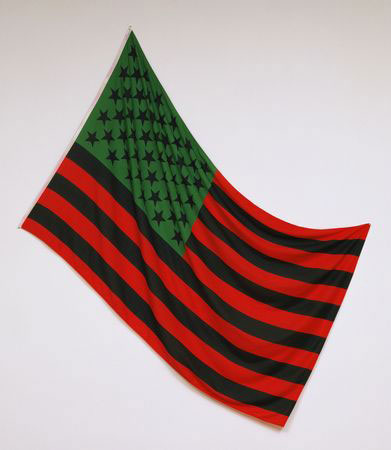
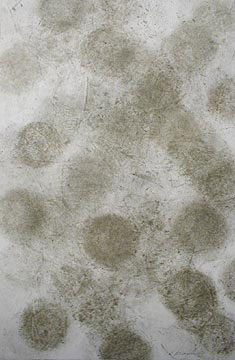

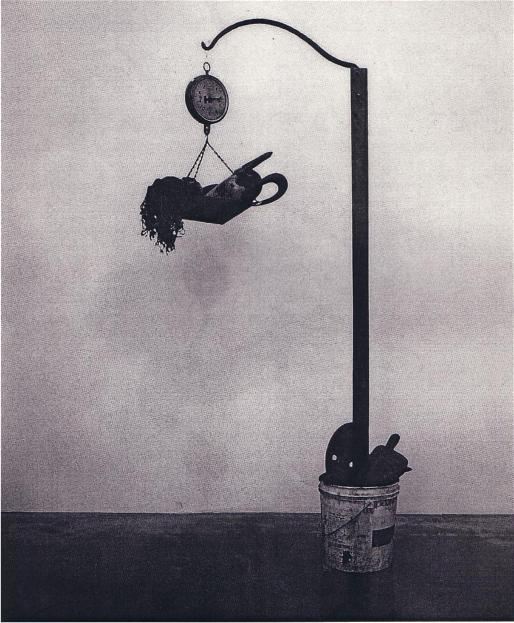
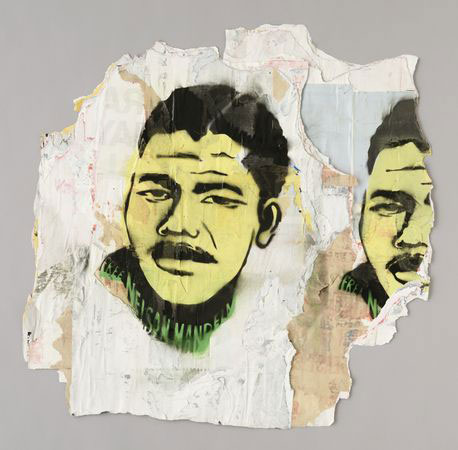

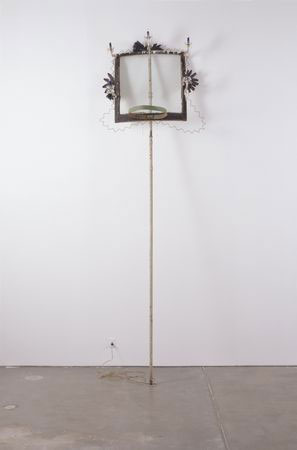
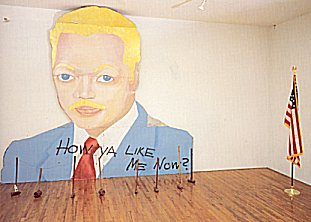
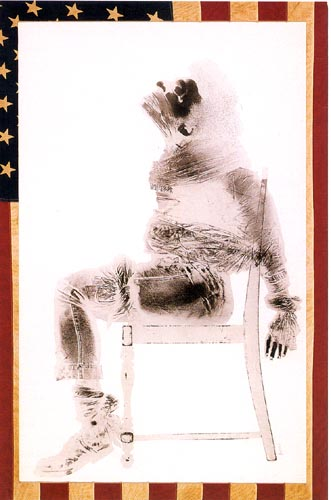
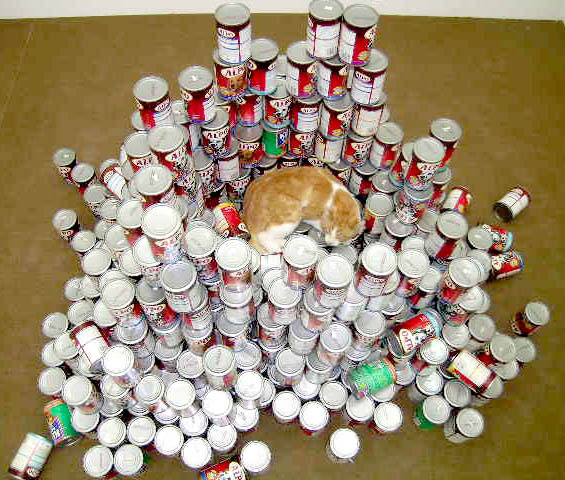
生于1943年在美国Springfield,居住和工作于纽约
David Hammons 善于制作影响大的小介入。“我做的越来越少,我就越来越是一个艺术家”。 他1983年在纽约做了一个行为叫“Bliz-aard Ball Sale”:他跟路上的小买方站在一起卖不同尺寸的雪球。他通过这个作品表达市场的一些规定:只要背景合适就可以麦任何东西,他在这里也批评艺术市场:什么都能卖包括毫无意义的物品。
Hammon的作品经常带讽刺感而比较刺激。他也喜欢在作品里放一些非洲传统的因素,不管是材料或感觉。
Hammon 参加过以下展览:
Hammons' works could/can be seen in the following exhibitions:
“2006年光州双年展“,2006年9月-11月,韩国
“黑豹阶级”,2006年3月-7月,三藩市
“洛杉矶 1955-1985”,2006 年2月-3月,蓬皮杜艺术中心,法国
“David Hammons: Phat Free”, 2006年2月-3月,美国
"Gwangju Biennale 2006", September-November 2006, Gwangju, South Korea
"Black Panther Rank and File", March-July 2006, Yerba Buena Center for the Arts, San Francisco
"Los Angeles 1955-1985", March-July 2006, Centre Pompidou, Paris
"David Hammons: Phat Free", Februar-May 2006, Saint Louis Art Museum, St. Louis
Biography
David Hammons is a master of minor artistic intervention that triggers major effects: "The less I do, the more artist I am." His performance, 'Bliz-aard Ball Sale' of 1983 on Cooper Square in New York is an excellent example to underline this statement. Standing between street vendors, Hammons offered snow balls, sorted by size, for sale. The artist wanted to illustrate that given the right setting, anything can be commercialized. This was also a reference to the art market, functioning along similar principals, where even seemingly senseless objects are given a price.
Like in this performance, that also uses urban experiences, Hammons' works generally contain a streak of irony, even sarcasm, which, at second glance, give his projects an aggressive air. For the artist it is also important to integrate African traditions into his work. This can be seen in either his choice of materials, or his preference of multi-colored patterns and spiritual aspects. The 'Rock Head' (2004), for example, is an oval boulder found in Harlem, upon which hair, swept from a Harlem barbershop floor, had been glued, then given a haircut by the same barber. Hammons, who participated at documenta in 1992 and at the Venice Biennale in 2003, takes a growing distance to the world of art. In spite of many invitations, he participates only in selected exhibits.
[attachment=46001]
African -American Flad, 1990
非洲-美国旗,1990
[attachment=46002]
B Ball, 1998, dirt on paper
[attachment=46003]
Basket ball installation, 1995
篮球装置,1995
[attachment=46004]
African Stand, 1991
[attachment=46005]
Free Mandela
[attachment=46006]
Champ, 1989
[attachment=46007]
1990
[attachment=46008]
How do they like us now, 1988
他们现在怎么喜欢我们,1988
[attachment=46009]
Injustice case, 1970
[attachment=46010]
This and That
这个和那个










摘自与 David Hammons 的访谈
From An Interview with David Hammons:
1. 我受不了艺术,其实我从来从来没有喜欢过艺术,我从来也没有学过艺术。
2. 我在加利福尼亚的时候,艺术家花几年时间做作品而从来不展出它们,所以对我来说参加展览从来不是很重要的事情。我们以前经常骂人:买我们作品的人、中间商,等等,因为对我们来说当艺术家,这个方面是个玩笑。
我来纽约的时候,我没看到这些方面。大家只在趴伏、寻找空间里的任何有钱的人。那里没有坏人,所以我说 “让我当坏人,或式一下当坏人,或跟坏人混而看效果怎么杨”。
3. 我一直在想理解为什么黑人被叫成“黑桃”, 与梅花牌相反。我记得以前有人叫我“黑桃”而我当时不知道什么意思,我知道“黑鬼”这个说法但“黑桃”我还是不知道。所以我用了它的形式而开始把它画出来。
4. 我特别喜欢南方的房子,它们的建筑。这种黑人建筑方式。我特别喜欢看黑人怎么做东西,比如说房子或哈莱姆(纽约黑人住的地区)的买报亭。包括我们木工工作方式:尺寸都不合适,但都能用。门能够关上,还是可以避免东西进来。但是不是很细,不按照白人的方式,所有的东西都是一个英寸的30秒钟。
5. 所以我喜欢在路上做东西,这样艺术就变成日常生活的一个物品。你通过他运动,而不比其它东西伟大。
这些作品的目的为让黑人观众反省。白人观众看这些作品像看另外一个文化一样而基本上不寻找他们自己的事情在里面。
6. 谁想当艺术家必须知道是决定走一个穷人的路。进去这个职业相当于进去寺院,我一直认为是一种选择贫穷的誓言。当艺术家而不跟穷事儿有关就是浪费时间。
我的焦点是尽量拿到很多钱回家。放弃太贵的艺术形式/媒体。作品必须先尽量便宜而好看。达到了这些之后就可以而我对这件事情感兴趣。
7.我不知道我的作品是什么。我只能等有人给我说。
我想烧一个作品,我觉得视觉上会比较好看。拍下来它烧的过程。拍下来的记录就可以当作品。我最近对这个感兴趣:拍下来的记录是作品而作品已经不存在了。
8. 如果你知道你是谁你就容易做作品。一般来说人很关心自己的形象。艺术家也愿意这样,他们希望有人看到他们所以一直说“可以”,但他们其实应该说“不行”。我做路上的作品因为跟我“我是谁”的基础有关系。因为发生的事情,只在路上发生的,这个是发生事情的地方,而不在画廊里发生的。
9.我觉得在路上做事情比艺术有力量。因为艺术变成这么。。。我现在不知道艺术他妈的是什么。跟马尔科姆X 说的完全两回事儿,像奴佛卡因(一种麻醉药)。以前会让你醒过来但现在让你睡下去。在这个城市里有这么多事情关于艺术现在就反而没什么意义。所以现在艺术家必须很关心他展出什么而什么时候展出。因为现在人不看艺术,而互相看,看其他人穿的衣服和其他人的发型。
10.艺术观众是世界上最差的观众。这个观众过分地受了教育、太保守、只会批评而不会去理解,而不好玩。我为什么要跟这种观众玩?
1. I CAN'T STAND ART ACTUALLY. I'VE NEVER, EVER LIKED ART, EVER. I NEVER TOOK IT IN SCHOOL.
2. WHEN I WAS IN CALIFORNIA, ARTISTS WOULD WORK FOR YEARS AND NEVER HAVE A SHOW. SO SHOWING HAS NEVER BEEN THAT IMPORTANT TO ME. WE USED TO CUSS PEOPLE OUT: PEOPLE WHO BOUGHT OUR WORK, DEALERS, ETC., BECAUSE THAT PART OF BEING AN ARTIST WAS ALWAYS A JOKE TO US.
WHEN I CAME TO NEW YORK, I DIDN'T SEE ANY OF THAT. EVERYBODY WAS JUST GROVELING AND TOMMING, ANYTHING TO BE IN THE ROOM WITH SOMEBODY WITH SOME MONEY. THERE WERE NO BAD GUYS HERE; SO I SAID, "LET ME BE A BAD GUY," OR ATTEMPT TO BE A BAD GUY, OR PLAY WITH THE BAD AREAS AND SEE WHAT HAPPENS.
3. I WAS TRYING TO FIGURE OUT WHY BLACK PEOPLE WERE CALLED SPADES, AS OPPOSED TO CLUBS. BECAUSE I REMEMBER BEING CALLED A SPADE ONCE, AND I DIDN'T KNOW WHAT IT MEANT; NIGGER I KNEW BUT SPADE I STILL DON'T. SO I TOOK THE SHAPE, AND STARTED PAINTING IT.
4. I JUST LOVE THE HOUSES IN THE SOUTH, THE WAY THEY BUILT THEM. THAT NEGRITUDE ARCHITECTURE. I REALLY LOVE TO WATCH THE WAY BLACK PEOPLE MAKE THINGS, HOUSES OR MAGAZINE STANDS IN HARLEM, FOR INSTANCE. JUST THE WAY WE USE CARPENTRY. NOTHING FITS, BUT EVERYTHING WORKS. THE DOOR CLOSES, IT KEEPS THINGS FROM COMING THROUGH. BUT IT DOESN'T HAVE THAT NEATNESS ABOUT IT, THE WAY WHITE PEOPLE PUT THINGS TOGETHER; EVERYTHING IS A THIRTY-SECOND OF AN INCH OFF.
5. THAT'S WHY I LIKE DOING STUFF BETTER ON THE STREET, BECAUSE THE ART BECOMES JUST ONE OF THE OBJECTS THAT'S IN THE PATH OF YOUR EVERYDAY EXISTENCE. IT'S WHAT YOU MOVE THROUGH, AND IT DOESN'T HAVE ANY SENIORITY OVER ANYTHING ELSE.
THOSE PIECES WERE ALL ABOUT MAKING SURE THAT THE BLACK VIEWER HAD A REFLECTION OF HIMSELF IN THE WORK. WHITE VIEWERS HAVE TO LOOK AT SOMEONE ELSE'S CULTURE IN THOSE PIECES AND SEE VERY LITTLE OF THEMSELVES IN IT.
6. ANYONE WHO DECIDES TO BE AN ARTIST SHOULD REALIZE THAT IT'S A POVERTY TRIP. TO GO INTO THIS PROFESSION IS LIKE GOING INTO THE MONASTERY OR SOMETHING; IT'S A VOW OF POVERTY I ALWAYS THOUGHT. TO BE AN ARTIST AND NOT EVEN TO DEAL WITH THAT POVERTY THING, THAT'S A WASTE OF TIME; OR TO BE AROUND PEOPLE COMPLAINING ABOUT THAT.
MY KEY IS TO TAKE AS MUCH MONEY HOME AS POSSIBLE. ABANDON ANY ART FORM THAT COSTS TOO MUCH. INSIST THAT IT'S AS CHEAP AS POSSIBLE IS NUMBER ONE AND ALSO THAT IT'S AESTHETICALLY CORRECT. AFTER THAT ANYTHING GOES. AND THAT KEEPS EVERYTHING INTERESTING FOR ME.
7. I DON'T KNOW WHAT MY WORK IS. I HAVE TO WAIT TO HEAR THAT FROM SOMEONE.
I WOULD LIKE TO BURN THE PIECE. I THINK THAT WOULD BE NICE VISUALLY. VIDEOTAPE THE BURNING OF IT. AND SHOOT SOME SLIDES. THE SLIDES WOULD THEN BE A PIECE IN ITSELF. I'M GETTING INTO THAT NOW: THE SLIDES ARE THE ART PIECES AND THE ART PIECES DON'T EXIST.
8. IF YOU KNOW WHO YOU ARE THEN IT'S EASY TO MAKE ART. MOST PEOPLE ARE REALLY CONCERNED ABOUT THEIR IMAGE. ARTISTS HAVE ALLOWED THEMSELVES TO BE BOXED IN BY SAYING "YES" ALL THE TIME BECAUSE THEY WANT TO BE SEEN, AND THEY SHOULD BE SAYING "NO." I DO MY STREET ART MAINLY TO KEEP ROOTED IN THAT "WHO I AM." BECAUSE THE ONLY THING THAT'S REALLY GOING ON IS IN THE STREET; THAT'S WHERE SOMETHING IS REALLY HAPPENING. IT ISN'T HAPPENING IN THESE GALLERIES.
9. DOING THINGS IN THE STREET IS MORE POWERFUL THAN ART I THINK. BECAUSE ART HAS GOTTEN SO....I DON'T KNOW WHAT THE FUCK ART IS ABOUT NOW. IT DOESN'T DO ANYTHING. LIKE MALCOLM X SAID, IT'S LIKE NOVOCAINE. IT USED TO WAKE YOU UP BUT NOW IT PUTS YOU TO SLEEP. I THINK THAT ART NOW IS PUTTING PEOPLE TO SLEEP. THERE'S SO MUCH OF IT AROUND IN THIS TOWN THAT IT DOESN'T MEAN ANYTHING. THAT'S WHY THE ARTIST HAS TO BE VERY CAREFUL WHAT HE SHOWS AND WHEN HE SHOWS NOW. BECAUSE THE PEOPLE AREN'T REALLY LOOKING AT ART, THEY'RE LOOKING AT EACH OTHER AND EACH OTHER'S CLOTHES AND EACH OTHER'S HAIRCUTS.
10. THE ART AUDIENCE IS THE WORST AUDIENCE IN THE WORLD. IT'S OVERLY EDUCATED, IT'S CONSERVATIVE, IT'S OUT TO CRITICIZE NOT TO UNDERSTAND, AND IT NEVER HAS ANY FUN. WHY SHOULD I SPEND MY TIME PLAYING TO THAT AUDIENCE?
From An Interview with David Hammons:
1. 我受不了艺术,其实我从来从来没有喜欢过艺术,我从来也没有学过艺术。
2. 我在加利福尼亚的时候,艺术家花几年时间做作品而从来不展出它们,所以对我来说参加展览从来不是很重要的事情。我们以前经常骂人:买我们作品的人、中间商,等等,因为对我们来说当艺术家,这个方面是个玩笑。
我来纽约的时候,我没看到这些方面。大家只在趴伏、寻找空间里的任何有钱的人。那里没有坏人,所以我说 “让我当坏人,或式一下当坏人,或跟坏人混而看效果怎么杨”。
3. 我一直在想理解为什么黑人被叫成“黑桃”, 与梅花牌相反。我记得以前有人叫我“黑桃”而我当时不知道什么意思,我知道“黑鬼”这个说法但“黑桃”我还是不知道。所以我用了它的形式而开始把它画出来。
4. 我特别喜欢南方的房子,它们的建筑。这种黑人建筑方式。我特别喜欢看黑人怎么做东西,比如说房子或哈莱姆(纽约黑人住的地区)的买报亭。包括我们木工工作方式:尺寸都不合适,但都能用。门能够关上,还是可以避免东西进来。但是不是很细,不按照白人的方式,所有的东西都是一个英寸的30秒钟。
5. 所以我喜欢在路上做东西,这样艺术就变成日常生活的一个物品。你通过他运动,而不比其它东西伟大。
这些作品的目的为让黑人观众反省。白人观众看这些作品像看另外一个文化一样而基本上不寻找他们自己的事情在里面。
6. 谁想当艺术家必须知道是决定走一个穷人的路。进去这个职业相当于进去寺院,我一直认为是一种选择贫穷的誓言。当艺术家而不跟穷事儿有关就是浪费时间。
我的焦点是尽量拿到很多钱回家。放弃太贵的艺术形式/媒体。作品必须先尽量便宜而好看。达到了这些之后就可以而我对这件事情感兴趣。
7.我不知道我的作品是什么。我只能等有人给我说。
我想烧一个作品,我觉得视觉上会比较好看。拍下来它烧的过程。拍下来的记录就可以当作品。我最近对这个感兴趣:拍下来的记录是作品而作品已经不存在了。
8. 如果你知道你是谁你就容易做作品。一般来说人很关心自己的形象。艺术家也愿意这样,他们希望有人看到他们所以一直说“可以”,但他们其实应该说“不行”。我做路上的作品因为跟我“我是谁”的基础有关系。因为发生的事情,只在路上发生的,这个是发生事情的地方,而不在画廊里发生的。
9.我觉得在路上做事情比艺术有力量。因为艺术变成这么。。。我现在不知道艺术他妈的是什么。跟马尔科姆X 说的完全两回事儿,像奴佛卡因(一种麻醉药)。以前会让你醒过来但现在让你睡下去。在这个城市里有这么多事情关于艺术现在就反而没什么意义。所以现在艺术家必须很关心他展出什么而什么时候展出。因为现在人不看艺术,而互相看,看其他人穿的衣服和其他人的发型。
10.艺术观众是世界上最差的观众。这个观众过分地受了教育、太保守、只会批评而不会去理解,而不好玩。我为什么要跟这种观众玩?
1. I CAN'T STAND ART ACTUALLY. I'VE NEVER, EVER LIKED ART, EVER. I NEVER TOOK IT IN SCHOOL.
2. WHEN I WAS IN CALIFORNIA, ARTISTS WOULD WORK FOR YEARS AND NEVER HAVE A SHOW. SO SHOWING HAS NEVER BEEN THAT IMPORTANT TO ME. WE USED TO CUSS PEOPLE OUT: PEOPLE WHO BOUGHT OUR WORK, DEALERS, ETC., BECAUSE THAT PART OF BEING AN ARTIST WAS ALWAYS A JOKE TO US.
WHEN I CAME TO NEW YORK, I DIDN'T SEE ANY OF THAT. EVERYBODY WAS JUST GROVELING AND TOMMING, ANYTHING TO BE IN THE ROOM WITH SOMEBODY WITH SOME MONEY. THERE WERE NO BAD GUYS HERE; SO I SAID, "LET ME BE A BAD GUY," OR ATTEMPT TO BE A BAD GUY, OR PLAY WITH THE BAD AREAS AND SEE WHAT HAPPENS.
3. I WAS TRYING TO FIGURE OUT WHY BLACK PEOPLE WERE CALLED SPADES, AS OPPOSED TO CLUBS. BECAUSE I REMEMBER BEING CALLED A SPADE ONCE, AND I DIDN'T KNOW WHAT IT MEANT; NIGGER I KNEW BUT SPADE I STILL DON'T. SO I TOOK THE SHAPE, AND STARTED PAINTING IT.
4. I JUST LOVE THE HOUSES IN THE SOUTH, THE WAY THEY BUILT THEM. THAT NEGRITUDE ARCHITECTURE. I REALLY LOVE TO WATCH THE WAY BLACK PEOPLE MAKE THINGS, HOUSES OR MAGAZINE STANDS IN HARLEM, FOR INSTANCE. JUST THE WAY WE USE CARPENTRY. NOTHING FITS, BUT EVERYTHING WORKS. THE DOOR CLOSES, IT KEEPS THINGS FROM COMING THROUGH. BUT IT DOESN'T HAVE THAT NEATNESS ABOUT IT, THE WAY WHITE PEOPLE PUT THINGS TOGETHER; EVERYTHING IS A THIRTY-SECOND OF AN INCH OFF.
5. THAT'S WHY I LIKE DOING STUFF BETTER ON THE STREET, BECAUSE THE ART BECOMES JUST ONE OF THE OBJECTS THAT'S IN THE PATH OF YOUR EVERYDAY EXISTENCE. IT'S WHAT YOU MOVE THROUGH, AND IT DOESN'T HAVE ANY SENIORITY OVER ANYTHING ELSE.
THOSE PIECES WERE ALL ABOUT MAKING SURE THAT THE BLACK VIEWER HAD A REFLECTION OF HIMSELF IN THE WORK. WHITE VIEWERS HAVE TO LOOK AT SOMEONE ELSE'S CULTURE IN THOSE PIECES AND SEE VERY LITTLE OF THEMSELVES IN IT.
6. ANYONE WHO DECIDES TO BE AN ARTIST SHOULD REALIZE THAT IT'S A POVERTY TRIP. TO GO INTO THIS PROFESSION IS LIKE GOING INTO THE MONASTERY OR SOMETHING; IT'S A VOW OF POVERTY I ALWAYS THOUGHT. TO BE AN ARTIST AND NOT EVEN TO DEAL WITH THAT POVERTY THING, THAT'S A WASTE OF TIME; OR TO BE AROUND PEOPLE COMPLAINING ABOUT THAT.
MY KEY IS TO TAKE AS MUCH MONEY HOME AS POSSIBLE. ABANDON ANY ART FORM THAT COSTS TOO MUCH. INSIST THAT IT'S AS CHEAP AS POSSIBLE IS NUMBER ONE AND ALSO THAT IT'S AESTHETICALLY CORRECT. AFTER THAT ANYTHING GOES. AND THAT KEEPS EVERYTHING INTERESTING FOR ME.
7. I DON'T KNOW WHAT MY WORK IS. I HAVE TO WAIT TO HEAR THAT FROM SOMEONE.
I WOULD LIKE TO BURN THE PIECE. I THINK THAT WOULD BE NICE VISUALLY. VIDEOTAPE THE BURNING OF IT. AND SHOOT SOME SLIDES. THE SLIDES WOULD THEN BE A PIECE IN ITSELF. I'M GETTING INTO THAT NOW: THE SLIDES ARE THE ART PIECES AND THE ART PIECES DON'T EXIST.
8. IF YOU KNOW WHO YOU ARE THEN IT'S EASY TO MAKE ART. MOST PEOPLE ARE REALLY CONCERNED ABOUT THEIR IMAGE. ARTISTS HAVE ALLOWED THEMSELVES TO BE BOXED IN BY SAYING "YES" ALL THE TIME BECAUSE THEY WANT TO BE SEEN, AND THEY SHOULD BE SAYING "NO." I DO MY STREET ART MAINLY TO KEEP ROOTED IN THAT "WHO I AM." BECAUSE THE ONLY THING THAT'S REALLY GOING ON IS IN THE STREET; THAT'S WHERE SOMETHING IS REALLY HAPPENING. IT ISN'T HAPPENING IN THESE GALLERIES.
9. DOING THINGS IN THE STREET IS MORE POWERFUL THAN ART I THINK. BECAUSE ART HAS GOTTEN SO....I DON'T KNOW WHAT THE FUCK ART IS ABOUT NOW. IT DOESN'T DO ANYTHING. LIKE MALCOLM X SAID, IT'S LIKE NOVOCAINE. IT USED TO WAKE YOU UP BUT NOW IT PUTS YOU TO SLEEP. I THINK THAT ART NOW IS PUTTING PEOPLE TO SLEEP. THERE'S SO MUCH OF IT AROUND IN THIS TOWN THAT IT DOESN'T MEAN ANYTHING. THAT'S WHY THE ARTIST HAS TO BE VERY CAREFUL WHAT HE SHOWS AND WHEN HE SHOWS NOW. BECAUSE THE PEOPLE AREN'T REALLY LOOKING AT ART, THEY'RE LOOKING AT EACH OTHER AND EACH OTHER'S CLOTHES AND EACH OTHER'S HAIRCUTS.
10. THE ART AUDIENCE IS THE WORST AUDIENCE IN THE WORLD. IT'S OVERLY EDUCATED, IT'S CONSERVATIVE, IT'S OUT TO CRITICIZE NOT TO UNDERSTAND, AND IT NEVER HAS ANY FUN. WHY SHOULD I SPEND MY TIME PLAYING TO THAT AUDIENCE?
[attachment=46011]
Valerie Jouve
*1964 in Saint-Étienne, Frankreich, lives and works in Paris
1964年出生于法国Saint-Etienne, 居住和工作于法国巴黎
Valerie Jouve 的专业原来为人类学,她为了补充她的研究就开始拍照片。在路上拍人在他们的日常生活里,研究他们的习惯。
她的摄影方式带一些记者报道的因素。她的摄影由城市场景和走路的人构成的。
在她的作品她也关注到现实的问题和摄影的幻想方面(一个摄影只能显示过去的吗?)而自己开始编辑、摆拍、处理摄影、找演员、等等。
展览作品
[attachment=46555]
Valérie Jouve: Münsterlands (Münsterländer) (Foto: Thorsten Arendt/sp07)
[attachment=46556]
Valérie Jouve: Münsterlands (Münsterländer)
过往年作品:
[attachment=46012]
sans titre, 1994-95
无题,1994-95
[attachment=46013]
sans titre (les arbres), 2006
无题(树),2006
[attachment=46014]
sans titre (les arbres), 2006
无题(树),2006
[attachment=46015]
sans titre (les arbres), 2006
无题(树),2006
[attachment=46016]
sans titre (les facades), 2006
无题(面墙),2006
[attachment=46018]
sans titre (les figures avec Aurelia Negrea), 2006
无题 (肖像)2006
[attachment=46019]
sans titre (les passants), 2006
无题 (路人),2006
[attachment=46020]
sans titre (les passants), 2006
无题 (路人),2006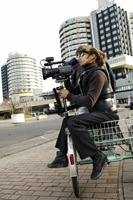
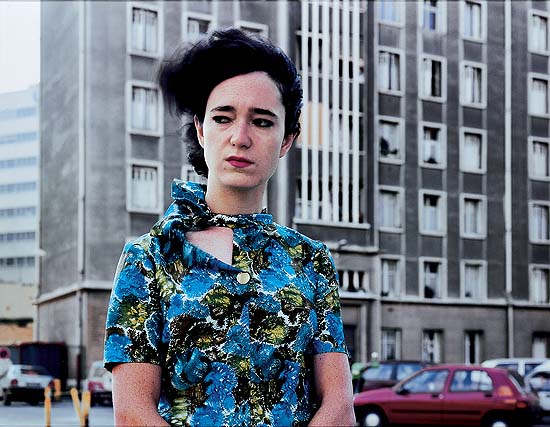
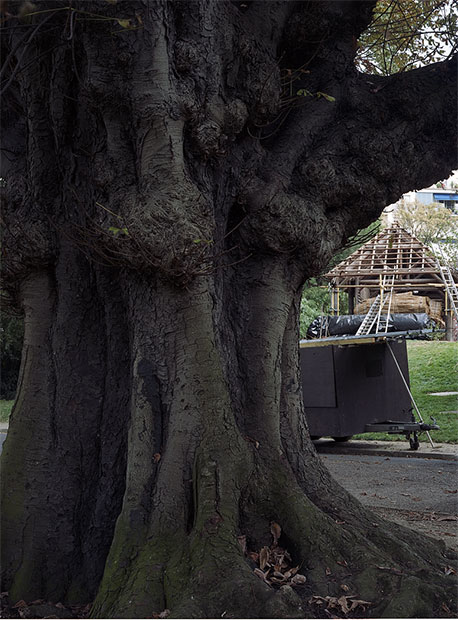

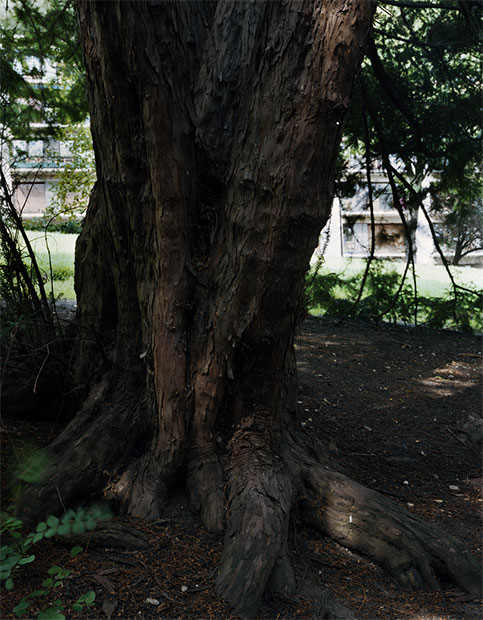
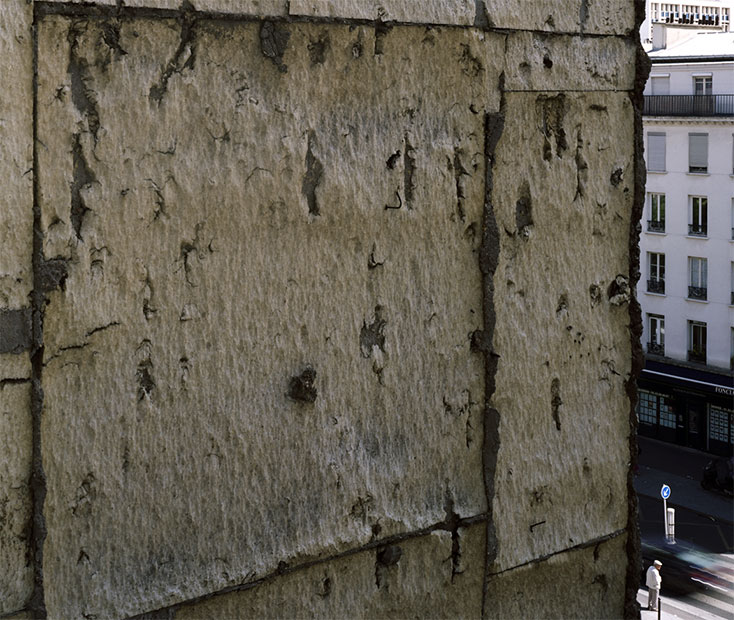
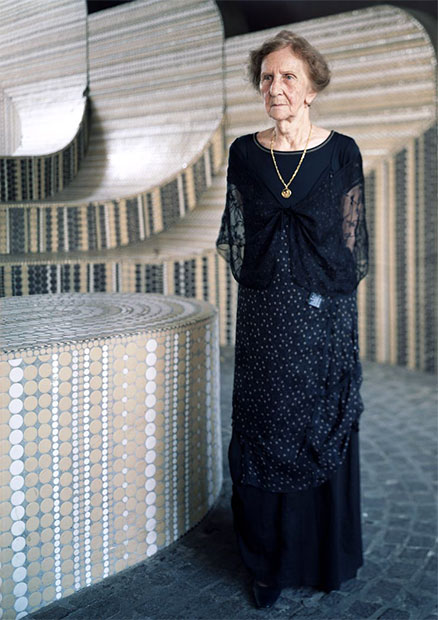
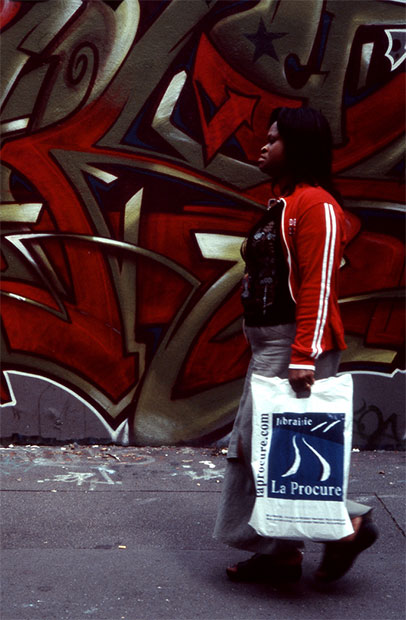

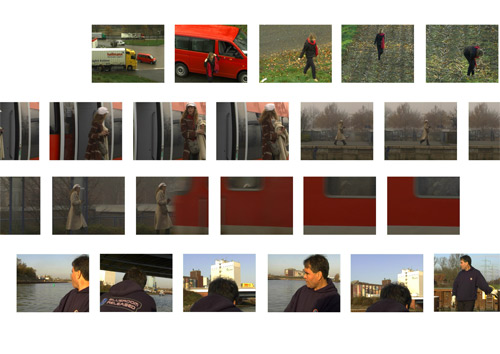
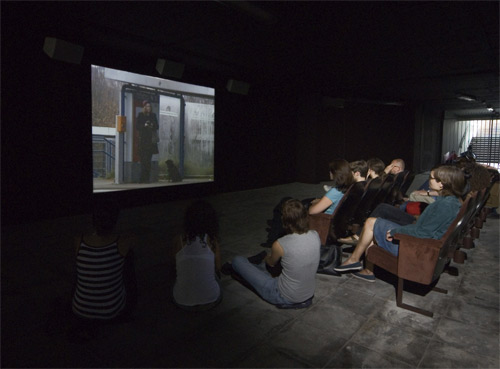
Valerie Jouve
*1964 in Saint-Étienne, Frankreich, lives and works in Paris
1964年出生于法国Saint-Etienne, 居住和工作于法国巴黎
Valerie Jouve 的专业原来为人类学,她为了补充她的研究就开始拍照片。在路上拍人在他们的日常生活里,研究他们的习惯。
她的摄影方式带一些记者报道的因素。她的摄影由城市场景和走路的人构成的。
在她的作品她也关注到现实的问题和摄影的幻想方面(一个摄影只能显示过去的吗?)而自己开始编辑、摆拍、处理摄影、找演员、等等。
展览作品
[attachment=46555]
Valérie Jouve: Münsterlands (Münsterländer) (Foto: Thorsten Arendt/sp07)
[attachment=46556]
Valérie Jouve: Münsterlands (Münsterländer)
过往年作品:
[attachment=46012]
sans titre, 1994-95
无题,1994-95
[attachment=46013]
sans titre (les arbres), 2006
无题(树),2006
[attachment=46014]
sans titre (les arbres), 2006
无题(树),2006
[attachment=46015]
sans titre (les arbres), 2006
无题(树),2006
[attachment=46016]
sans titre (les facades), 2006
无题(面墙),2006
[attachment=46018]
sans titre (les figures avec Aurelia Negrea), 2006
无题 (肖像)2006
[attachment=46019]
sans titre (les passants), 2006
无题 (路人),2006
[attachment=46020]
sans titre (les passants), 2006
无题 (路人),2006











匪夷的...
[attachment=46567]
Suchan Kinoshita
* 1960 in Tokyo, lives and works in Maastricht
1960年生于日本东京,居住和工作于荷兰的马斯特里赫特
展览作品
[attachment=46568]
Suchan Kinoshita: Chinese Whisper (Stille Post) (Foto: Roman Mensing/sp07)
[attachment=46569]
Suchan Kinoshita: Chinese Whisper (Stille Post) (Foto: Roman Mensing/sp07)
Kinoshita's work invites viewers to bridge art and theater in participatory experiences that emphasize movement, space, and time. Visitors are invited to enter a series of rough wooden box-like rooms that activate the architectural space along the museum's stairway to the second floor. A student of experimental theater, Kinoshita gently choreographs visitors' actions and their sensory perceptions as they move from container to container. Ordinary objects and experiences are stripped of their traditional identities as viewers become aware of everyday realities anew. The concept that movement, transience, and dispersal underscores the temporary nature of our lives is at the core of Kinoshita's work.
Suchan Kinoshita's work has been featured in international exhibitions since 1986, including 46th Venice Biennale and 4th Istanbul Biennale (1995); Manifesta 1, Rotterdam (1996); and Truce: Echoes of Art in an Age of Endless Conclusions, SITE Santa Fe, New Mexico, and Trade Routes: History and Geography. 2nd Johannesburg Biennale (1997). Her work has also been presented in such group exhibitions as Inklusion: Exklusion, Reininghaus and Künstlerhaus, Graz, Under Capricorn, Stedelijk Museum, Amsterdam, and Doppelbindung. Linke Maschen, Kunstverein, Munich (1996). Kinoshita has had solo exhibitions at De Fabrick, Eindhoven (1991); White Cube, London (1996); Stedelijk Van Abbemuseum, Eindhoven (1997); and Chisenhale Gallery, London (1998).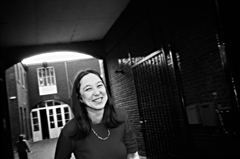
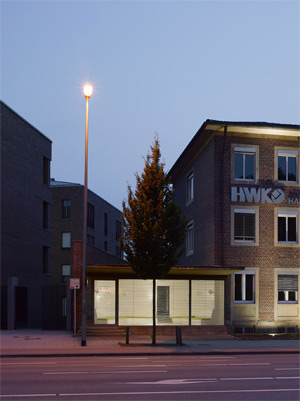
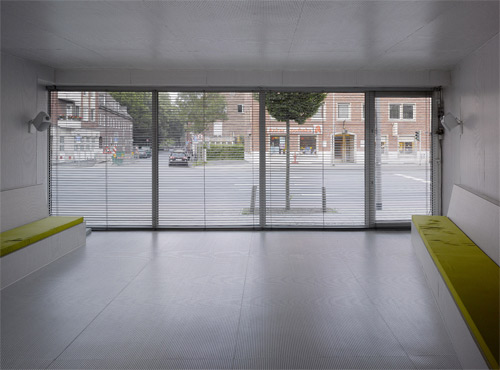
Suchan Kinoshita
* 1960 in Tokyo, lives and works in Maastricht
1960年生于日本东京,居住和工作于荷兰的马斯特里赫特
展览作品
[attachment=46568]
Suchan Kinoshita: Chinese Whisper (Stille Post) (Foto: Roman Mensing/sp07)
[attachment=46569]
Suchan Kinoshita: Chinese Whisper (Stille Post) (Foto: Roman Mensing/sp07)
Kinoshita's work invites viewers to bridge art and theater in participatory experiences that emphasize movement, space, and time. Visitors are invited to enter a series of rough wooden box-like rooms that activate the architectural space along the museum's stairway to the second floor. A student of experimental theater, Kinoshita gently choreographs visitors' actions and their sensory perceptions as they move from container to container. Ordinary objects and experiences are stripped of their traditional identities as viewers become aware of everyday realities anew. The concept that movement, transience, and dispersal underscores the temporary nature of our lives is at the core of Kinoshita's work.
Suchan Kinoshita's work has been featured in international exhibitions since 1986, including 46th Venice Biennale and 4th Istanbul Biennale (1995); Manifesta 1, Rotterdam (1996); and Truce: Echoes of Art in an Age of Endless Conclusions, SITE Santa Fe, New Mexico, and Trade Routes: History and Geography. 2nd Johannesburg Biennale (1997). Her work has also been presented in such group exhibitions as Inklusion: Exklusion, Reininghaus and Künstlerhaus, Graz, Under Capricorn, Stedelijk Museum, Amsterdam, and Doppelbindung. Linke Maschen, Kunstverein, Munich (1996). Kinoshita has had solo exhibitions at De Fabrick, Eindhoven (1991); White Cube, London (1996); Stedelijk Van Abbemuseum, Eindhoven (1997); and Chisenhale Gallery, London (1998).



嘿社会牛鼻啊
[attachment=46580]
Marko Lehanka
*1961 Herborn (Hessen), lives and works in Frankfurt and Butzbach
1961年出生于德国hessen, 居住并工作于德国弗兰克福和Butzbach
Project description 展览作品计划
[attachment=46581]
Marko Lehanka: Blume für Münster (Arendt Mensing/sp07)
[attachment=46582]
Marko Lehanka: Blume für Münster (Arendt Mensing/sp07)
On Prinzipalmarkt, the main shopping street in Münster, the artist Marko Lehanka wants to install a huge flower. The petals are made of surfboards, the calyx consists of a monitor and speakers, connected to a computer. The flower attracts passers-by, to tell them stories. The computer replaces the author: Lehanka has spent several years developing a software, that generates stories about Münster, on the basis of words stored in the memory of the computer. Through the speakers, the audience can hear the computer telling the stories, and can read the words on the screen. The end is always the same: All stories end with the death of the protagonist. An irritating reading, indeed.
Marko Lehanka's world is trivial, and the beholder does not only recognise his/her everyday life in his works, but the banal character of events, which, at first glance, is a surprise. Since 1991 he has produced several series of 'Beer bottles', which are embossed with the typical fragments of sentences we hear in drinking bouts: all areas of life covered. The persiflage is another typical stylistic feature of Lehanka's art. He designed a room in the Museum of Modern Art (MMK) Frankfurt in the year 2000, where he showed for example a construction inspired by Albrecht Dürer's 'Bauernsäule' (1525), with the same title, however not crowned by a murdered peasant, but by a farmer, casually smoking a cigarette. Lehanka studied at Städelschule in Frankfurt from 1985 to 1990, and was awarded the Villa Romana Prize in Florence in 1993. He participated in the Venice Biennale in 2001, where he arranged an installation around the 'Bauernsäule' in the Italian Pavilion. Lehanka frequently uses improvisation and spontaneous ideas, which either become an integral component of his work, or whose spirit inspires his action or performance. The artist and his alternating assistants from the 'Mädcheninstitut Lehanka', which he founded in 1993, often move along the boundary between nonsense and absurdity. Lehanka uses many different artistic media, and has always been an expert in style, and an excellent observer of everyday life, which he knows to encounter with humour.
Lehanka's works could/can be seen in the following exhibitions:
"Lido", November 2005, Kunsthalle Düsseldorf
"Ein Arkadien der Moderne: Villa Romana", October 2005-January 2006, Neues Museum, Weimar
"Bidibidobidiboo", May-October 2005, Fondazione Sandretto Re Rebaudengo, Turin
"Zur Kasse bitte", May-September 2005, Ludwig Forum, Aachen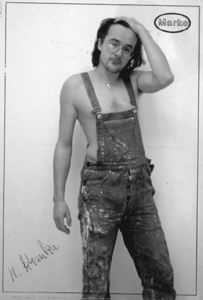
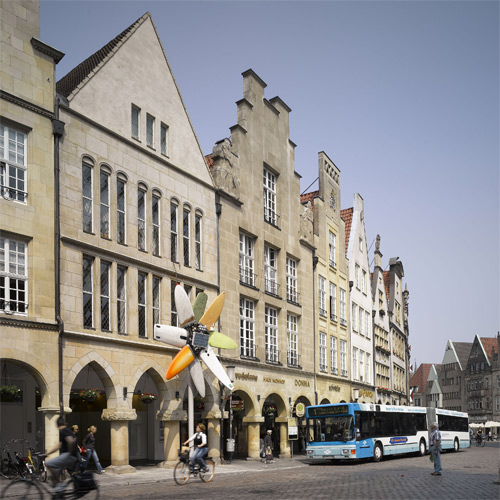
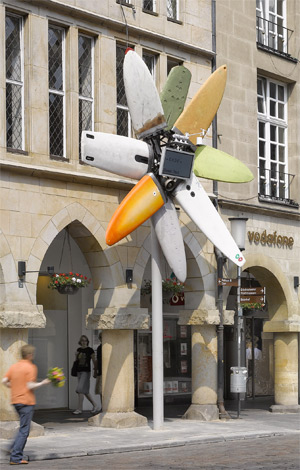
Marko Lehanka
*1961 Herborn (Hessen), lives and works in Frankfurt and Butzbach
1961年出生于德国hessen, 居住并工作于德国弗兰克福和Butzbach
Project description 展览作品计划
[attachment=46581]
Marko Lehanka: Blume für Münster (Arendt Mensing/sp07)
[attachment=46582]
Marko Lehanka: Blume für Münster (Arendt Mensing/sp07)
On Prinzipalmarkt, the main shopping street in Münster, the artist Marko Lehanka wants to install a huge flower. The petals are made of surfboards, the calyx consists of a monitor and speakers, connected to a computer. The flower attracts passers-by, to tell them stories. The computer replaces the author: Lehanka has spent several years developing a software, that generates stories about Münster, on the basis of words stored in the memory of the computer. Through the speakers, the audience can hear the computer telling the stories, and can read the words on the screen. The end is always the same: All stories end with the death of the protagonist. An irritating reading, indeed.
Marko Lehanka's world is trivial, and the beholder does not only recognise his/her everyday life in his works, but the banal character of events, which, at first glance, is a surprise. Since 1991 he has produced several series of 'Beer bottles', which are embossed with the typical fragments of sentences we hear in drinking bouts: all areas of life covered. The persiflage is another typical stylistic feature of Lehanka's art. He designed a room in the Museum of Modern Art (MMK) Frankfurt in the year 2000, where he showed for example a construction inspired by Albrecht Dürer's 'Bauernsäule' (1525), with the same title, however not crowned by a murdered peasant, but by a farmer, casually smoking a cigarette. Lehanka studied at Städelschule in Frankfurt from 1985 to 1990, and was awarded the Villa Romana Prize in Florence in 1993. He participated in the Venice Biennale in 2001, where he arranged an installation around the 'Bauernsäule' in the Italian Pavilion. Lehanka frequently uses improvisation and spontaneous ideas, which either become an integral component of his work, or whose spirit inspires his action or performance. The artist and his alternating assistants from the 'Mädcheninstitut Lehanka', which he founded in 1993, often move along the boundary between nonsense and absurdity. Lehanka uses many different artistic media, and has always been an expert in style, and an excellent observer of everyday life, which he knows to encounter with humour.
Lehanka's works could/can be seen in the following exhibitions:
"Lido", November 2005, Kunsthalle Düsseldorf
"Ein Arkadien der Moderne: Villa Romana", October 2005-January 2006, Neues Museum, Weimar
"Bidibidobidiboo", May-October 2005, Fondazione Sandretto Re Rebaudengo, Turin
"Zur Kasse bitte", May-September 2005, Ludwig Forum, Aachen


